Samsung Electronics Co STHA255 Dual-Mode Cellular (AMPS/TDMA) Phone User Manual
Samsung Electronics Co Ltd Dual-Mode Cellular (AMPS/TDMA) Phone Users Manual
Contents
Users Manual

Printed in Korea
Code No. : GH68-xxxxxA
English. 02/2002. Rev. 1.0
ELECTRONICS
World Wide Web
http://www.samsungmobile.com
TDMA MOBILE
TELEPHONE
STH-A255
Draft version
(2002/01/25)
* Some contents in this manual may differ from your phone depending on
the software of the phone or your service provider.
Please, be sure to read this
manual before using your phone.
And keep the manual after
reading it and use any time you
have a question.

For more information about RF exposure, please visit the FCC website at www.fcc.gov
FCC RF EXPOSURE INFORMATION
In August 1996 the Federal Communications Commission (FCC) of the United States
with its action in Report and Order FCC 96-326 adopted an updated safety standard
for human exposure to radio frequency electromagnetic energy emitted by FCC
regulated transmitters. Those guidelines are consistent with the safety standard
previously set by both U.S. and international standards bodies. The design of this
phone complies with the FCC guidelines and these international standards.
Use only the supplied or an approved antenna. Unauthorized antennas, modifications,
or attachments could impair call quality, damage the phone, or result in violation of
FCC regulations.
Do not use the phone with a damaged antenna. If a damaged antenna comes into
contact with the skin, a minor burn may result. Please contact your local dealer for
replacement antenna.
Body-worn Operation
This device was tested for typical body-worn operations with the back of the phone
kept 2.0cm. from the body. To maintain compliance with FCC RF exposure
guidelines, use only belt-clips, holsters or similar accessories that maintain a 2.0cm
separation distance between the user’s body and the back of the phone, including the
antenna, whether extended or retracted. The use of third-party belt-clips, holsters and
similar accessories should not contain metallic components in its assembly. The use of
accessories that do not satisfy these requirements may not comply with FCC RF
exposure guidelines, and should be avoided.
WARNING! Read this information before using your phone

ii
i
FCC RF EXPOSURE INFORMATION
In August 1996 the Federal Communications Commission (FCC) of
the United States with its action in Report and Order FCC 96-326
adopted an updated safety standard for human exposure to radio
frequency electromagnetic energy emitted by FCC regulated
transmitters. Those guidelines are consistent with the safety
standard previously set by both U.S. and international standards
bodies. The design of this phone complies with the FCC
guidelines and these international standards.
Use only the supplied or an approved antenna. Unauthorized
antennas, modifications, or attachments could impair call quality,
damage the phone, or result in violation of FCC regulations.
Do not use the phone with a damaged antenna. If a damaged
antenna comes into contact with the skin, a minor burn may
result. Please contact your local dealer for replacement antenna.
Body-worn Operation
This device was tested for typical body-worn operations with
the back of the phone kept 0.78inches (2.0cm) from the
body. To maintain compliance with FCC RF exposure guidelines
use only belt-clips, holster or similar accessories that maintain
a 0.78inches (2.0cm) separation between the user’s body and
the phone, including the antenna, whether extended or retracted
The use of third-party belt-clips, holsters and similar accessories
should not contain metallic components in the assembly. The use
of accessories that do not satisfy these requirements may not
with FCC RF exposure guidelines, and should be avoided.
Vehicle Mounted External Antenna (optional, if
available.)
A minimum separation distance of 7.9 inches (20cm) must be
maintained Between a person and the vehicle mounted external
antenna to satisfy FCC RF exposure requirements.
For more information about RF exposure, please visit the FCC
website at www.fcc.gov
SAR Information & FCC ID Labeling
THIS MODEL PHONE MEETS THE GOVERNMENT’S
REQUIREMENTS FOR EXPOSURE TO RADIO WAVES.
Your wireless phone is a radio transmitter and receiver. It is
designed and manufactured not to exceed the emission limits for
exposure to radiofrequency (RF) energy set by the Federal
Communications Commission of the U.S. Government. These
limits are part of comprehensive guidelines and establish
permitted levels of RF energy for the general population. The
guidelines are based on standards that were developed by
independent scientific organizations through periodic and
thorough evaluation of scientific studies. The standards include a
substantial safety margin designed to assure the safety of all
persons, regardless of age and health.
The exposure standard for wireless mobile phones employs a
unit of measurement know as the Specific Absorption Rate, or
SAR. The SAR limit set by the FCC is 1.6W/kg.* Tests for SAR
are conducted using standard operating positions specified by
the FCC with the phone transmitting at its highest certified
power level in all tested frequency bands. Although the SAR is
determined at the highest certified power level, the actual SAR
level of the phone while operating can be well below the
maximum value. This is because the phone is designed to
operate at multiple power levels so as to use only the power
required to reach the network. In general, the closer you are to a
wireless base station antenna, the lower the power output.
Before a phone model is available for sale to the public, it must
be tested and certified to the FCC that it does not exceed the
limit established by the government-adopted requirement for
safe exposure. The tests are performed in positions and locations
(e.g., at the ear and worn on the body) as required by the FCC for
each model. The highest SAR value for this model phone when
tested for use at the ear is 1.484 W/kg and when worn on the
body, as described in this user guide, is 1.240 W/kg . (Body-worn
measurements differ among phone models, depending upon
available accessories and FCC requirements). While there may
be differences between the SAR levels of various phones and at
various positions, they all meet the government requirement for
safe exposure.

1
Contents
Unpacking. . . . . . . . . . . . . . . . . . . . . . . . . . . . . . . . . . 7
Your Phone
Phone Layout. . . . . . . . . . . . . . . . . . . . . . . . . . . . . . . . . 8
Display. . . . . . . . . . . . . . . . . . . . . . . . . . . . . . . . . . . . . 11
Service Light . . . . . . . . . . . . . . . . . . . . . . . . . . . . . . . . 14
Getting Started
Installing the Battery . . . . . . . . . . . . . . . . . . . . . . . . . . 15
Charging a Battery. . . . . . . . . . . . . . . . . . . . . . . . . . . . 17
Switching the Phone On/Off . . . . . . . . . . . . . . . . . . . . . 19
Locking Your Phone . . . . . . . . . . . . . . . . . . . . . . . . . . . 20
Call Functions
Making a Call. . . . . . . . . . . . . . . . . . . . . . . . . . . . . . . . 21
Making a Call from the Phonebook. . . . . . . . . . . . . . . . 22
Redialing the Last Number . . . . . . . . . . . . . . . . . . . . . . 22
Adjusting the Volume . . . . . . . . . . . . . . . . . . . . . . . . . . 23
Answering a Call . . . . . . . . . . . . . . . . . . . . . . . . . . . . . 24
Viewing Missed Calls. . . . . . . . . . . . . . . . . . . . . . . . . . 25
Quick-switching to Silent Mode . . . . . . . . . . . . . . . . . . . . 27
Selecting Functions and Options
Using the Soft Keys . . . . . . . . . . . . . . . . . . . . . . . . . . . . . . 28
Selecting Functions and Options . . . . . . . . . . . . . . . . . . . 29
Example: Setting the Display Language . . . . . . . . . . . . 30
Phonebook
Storing a Phone Number with a Name . . . . . . . . . . . . . 32
Speed Dialing by Memory Location . . . . . . . . . . . . . . . 33
Phonebook Options . . . . . . . . . . . . . . . . . . . . . . . . . . . 34
Searching for and Dialing
a Number in the Phonebook. . . . . . . . . . . . . . . . . 37
Name Options . . . . . . . . . . . . . . . . . . . . . . . . . . . . . . . 38
The FCC has granted an Equipment Authorization for this model
phone with all reported SAR levels evaluated as in compliance
with the FCC RF emission guidelines. SAR information on this
model phone is on file with the FCC and can be found under the
Display Grant section of http://www.fcc.gov/oet/fccid after
searching on FCC ID A3LSTHN270.
Additional information on Specific Absorption Rates (SAR) can
be found on the Cellular Telecommunications Industry
Association (CTIA) web-site at http://www.wow-com.com (see
note).
* In the United States and Canada, the SAR limit for mobile
phones used by the public is 1.6 watts/kg (W/kg) averaged over
one gram of tissue. The standard incorporates a substantial
margin of safety to give additional protection for the public and
to account for any variations in measurements.
Note: The URL http://phonefacts.net may be used in place
of http://www.wow-com.com for direct access to SAR
information.
iii

Entering Text
Changing the Text Input Mode . . . . . . . . . . . . . . . . . . . 42
Using the T9 Mode. . . . . . . . . . . . . . . . . . . . . . . . . . . . 43
Using the Upper/Lower-case Character Mode . . . . . . . 44
Using the Number Mode. . . . . . . . . . . . . . . . . . . . . . . . . . 45
In-Call Options
Muting/Sending Key Tones. . . . . . . . . . . . . . . . . . . . . . 46
Searching for a Number in the Phonebook . . . . . . . . . . 47
Using the SMS Service . . . . . . . . . . . . . . . . . . . . . . . . 48
Making a Calling card call . . . . . . . . . . . . . . . . . . . . . . . . 48
Making the Voice Call Private . . . . . . . . . . . . . . . . . . . . . . 49
Putting a Call on Hold. . . . . . . . . . . . . . . . . . . . . . . . . . 49
Answering a Second Call . . . . . . . . . . . . . . . . . . . . . . . 50
Making a 3-way Conference Call . . . . . . . . . . . . . . . . . 51
Using the Menus
Accessing a Menu Function by scrolling . . . . . . . . . . . 52
Accessing a Menu Function by Using its Shortcut . . . . 53
List of Menu Functions. . . . . . . . . . . . . . . . . . . . . . . . . 54
Call Records
Missed Calls (Menu 1.1). . . . . . . . . . . . . . . . . . . . . . . . 59
Incoming Calls (Menu 1.2) . . . . . . . . . . . . . . . . . . . . . . 59
Outgoing Calls (Menu 1.3). . . . . . . . . . . . . . . . . . . . . . . 60
Call Time (Menu 1.4). . . . . . . . . . . . . . . . . . . . . . . . . . . 60
Messages
Voice Mail (Menu 2.1). . . . . . . . . . . . . . . . . . . . . . . . . . 61
Read Messages (Menu 2.2) . . . . . . . . . . . . . . . . . . . . . 62
Write Messages (Menu 2.3) . . . . . . . . . . . . . . . . . . . . . 64
Preset Message List (Menu 2.4) . . . . . . . . . . . . . . . . . . 65
Setup (Menu 2.5) . . . . . . . . . . . . . . . . . . . . . . . . . . . . . 66
Picture Message (Menu 2.6). . . . . . . . . . . . . . . . . . . . . 67
Receiving Pictures, Ring Tones or Operator Logos . . . . 69
3
2
Sound Settings
Ring Volume (Menu 3.1) . . . . . . . . . . . . . . . . . . . . . . . . 72
Ring Tone (Menu 3.2) . . . . . . . . . . . . . . . . . . . . . . . . . . 72
Alert Type (Menu 3.3) . . . . . . . . . . . . . . . . . . . . . . . . . . 73
Tone Length (Menu 3.4) . . . . . . . . . . . . . . . . . . . . . . . . 73
Message Tone (Menu 3.5) . . . . . . . . . . . . . . . . . . . . . . 74
Error Tone (Menu 3.6). . . . . . . . . . . . . . . . . . . . . . . . . . 74
Minute Minder (Menu 3.7) . . . . . . . . . . . . . . . . . . . . . . 75
Connect Tone (Menu 3.8) . . . . . . . . . . . . . . . . . . . . . . . 75
Melody Composer . . . . . . . . . . . . . . . . . . . . . . . . . . . . 76
Phone Settings
Greeting Message (Menu 4.1). . . . . . . . . . . . . . . . . . . . 78
LCD Control (Menu 4.2). . . . . . . . . . . . . . . . . . . . . . . . . 78
Service Light (Menu 4.3). . . . . . . . . . . . . . . . . . . . . . . . 79
Auto Redial (Menu 4.4). . . . . . . . . . . . . . . . . . . . . . . . . 80
Answer Mode (Menu 4.5). . . . . . . . . . . . . . . . . . . . . . . 80
Language (Menu 4.6) . . . . . . . . . . . . . . . . . . . . . . . . . . 81
Reset Settings (Menu 4.7). . . . . . . . . . . . . . . . . . . . . . . 81
Calling card (Menu 4.8) . . . . . . . . . . . . . . . . . . . . . . . . 81
Shortcut (Menu 4.9) . . . . . . . . . . . . . . . . . . . . . . . . . . . 84
Organizer
Calendar (Menu 5.1). . . . . . . . . . . . . . . . . . . . . . . . . . . 85
To Do List (Menu 5.2) . . . . . . . . . . . . . . . . . . . . . . . . . . 87
Time & Date (Menu 5.3) . . . . . . . . . . . . . . . . . . . . . . . . 89
Alarm (Menu 5.4) . . . . . . . . . . . . . . . . . . . . . . . . . . . . . 91
Calculator (Menu 5.5). . . . . . . . . . . . . . . . . . . . . . . . . . 92
Security
Change Lock code (Menu 6.1) . . . . . . . . . . . . . . . . . . . 93
Change Security code (Menu 6.2). . . . . . . . . . . . . . . . . 93
Call Restriction (Menu 6.3) . . . . . . . . . . . . . . . . . . . . . . 94
SOS Call List (Menu 6.4) . . . . . . . . . . . . . . . . . . . . . . . . 95

5
4
Quick Safety Guide
Read these simple guidelines. Failure to comply with
them may be dangerous or illegal. For more detailed
safety information, see “Health and Safety
Information” on page xx.
Road safety comes first
Do not use a hand-held mobile phone while driving;
park the vehicle first.
Switch off when refuelling
Do not use the phone at a refuelling point (service
station) or near fuels or chemicals.
Switch off on aircraft
Mobile phones can cause interference. Using them
on aircraft is both illegal and dangerous.
Switch off in hospital
Follow any regulations or rules. Switch phone off
near medical equipment.
Respect special regulations
Follow any special regulations in force in any area
and always switch off your phone whenever it is
forbidden to use it, or when it may cause
interference or danger (in a hospital for example).
Interference
All wireless phones may be subject to radio
interference, which may affect their performance.
Network Services
Call Diverting (Menu 7.1) . . . . . . . . . . . . . . . . . . . . . . . 96
Call Waiting (Menu 7.2) . . . . . . . . . . . . . . . . . . . . . . . . 97
Network Selection (Menu 7.3) . . . . . . . . . . . . . . . . . . . 98
Voice Privacy (Menu 7.4) . . . . . . . . . . . . . . . . . . . . . . . 99
NAM Selection(Menu 7.5) . . . . . . . . . . . . . . . . . . . . . . 99
Set Service Code(Menu 7.6) . . . . . . . . . . . . . . . . . . . . 100
Publick System Selection (Menu 7.7) . . . . . . . . . . . . . 101
Games . . . . . . . . . . . . . . . . . . . . . . . . . . . . . . . . . . . 102
WAP Browser. . . . . . . . . . . . . . . . . . . . . . . . . . . . . 104
Voice Memo
Record . . . . . . . . . . . . . . . . . . . . . . . . . . . . . . . . . . . 105
Replay & Delete. . . . . . . . . . . . . . . . . . . . . . . . . . . . . 107
Edit Title . . . . . . . . . . . . . . . . . . . . . . . . . . . . . . . . . . 108
Solving Problems . . . . . . . . . . . . . . . . . . . . . . . . . . 109
Health and Safety Information . . . . . . . . . . . . . . . 111
Glossary. . . . . . . . . . . . . . . . . . . . . . . . . . . . . . . . . . 126
Index . . . . . . . . . . . . . . . . . . . . . . . . . . . . . . . . . . . . 129
Quick Reference Card . . . . . . . . . . . . . . . . . . . . . . 133
FDA Consumer Update. . . . . . . . . . . . . . . . . . . . . . 135
available when you set the service code in the Set Service Code
menu option (7.6).
*
*
*
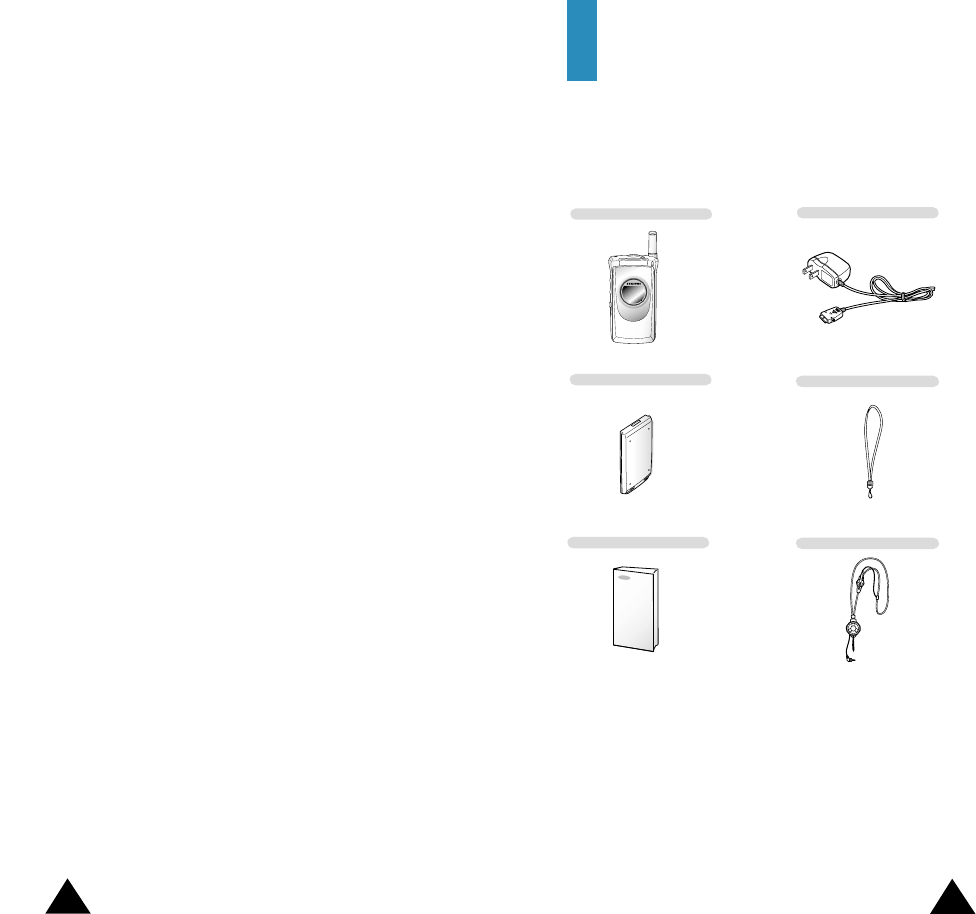
In addition, you can obtain the following accessories for
your phone from your local SAMSUNG dealer:
• Desktop charger
• Hands-free kit
• Standard/Extended battery
• Cigarette lighter adapter
• Ear-microphone
• Leather case
7
6
Travel Charger
Handset
User’s Manual
Radio frequency exposure information
In August 1996, the Federal Communications
Commission (FCC) of the U.S. adopted an updated
safety standard for human exposure to radio
frequency electromagnetic energy emitted by FCC
regulated transmitters. The design of this phone
complies with the FCC guidelines and these
international standards.
To maintain compliance with FCC RF exposure
guidelines, if you wear a handset on your body, use
the SAMSUNG-supplied or approved carrying case,
holster, or other body-worn accessory.
If you do not use a body-worn accessory, ensure the
antenna is at least 0.78 inch (2.0 cm) from your body
when transmitting. Use of non-approved accessories
may violate FCC RF exposure guidelines.
Use sensibly
Use only in the normal position (to ear). Do not touch
the antenna unnecessarily when the phone is
switched on.
Accessories and batteries
Use only SAMSUNG-approved accessories and
batteries.
Use qualified service
Only qualified service personnel must repair
equipment.
Unpacking
Your package contains the following items.
Battery Hand Strap
Ear-microphone
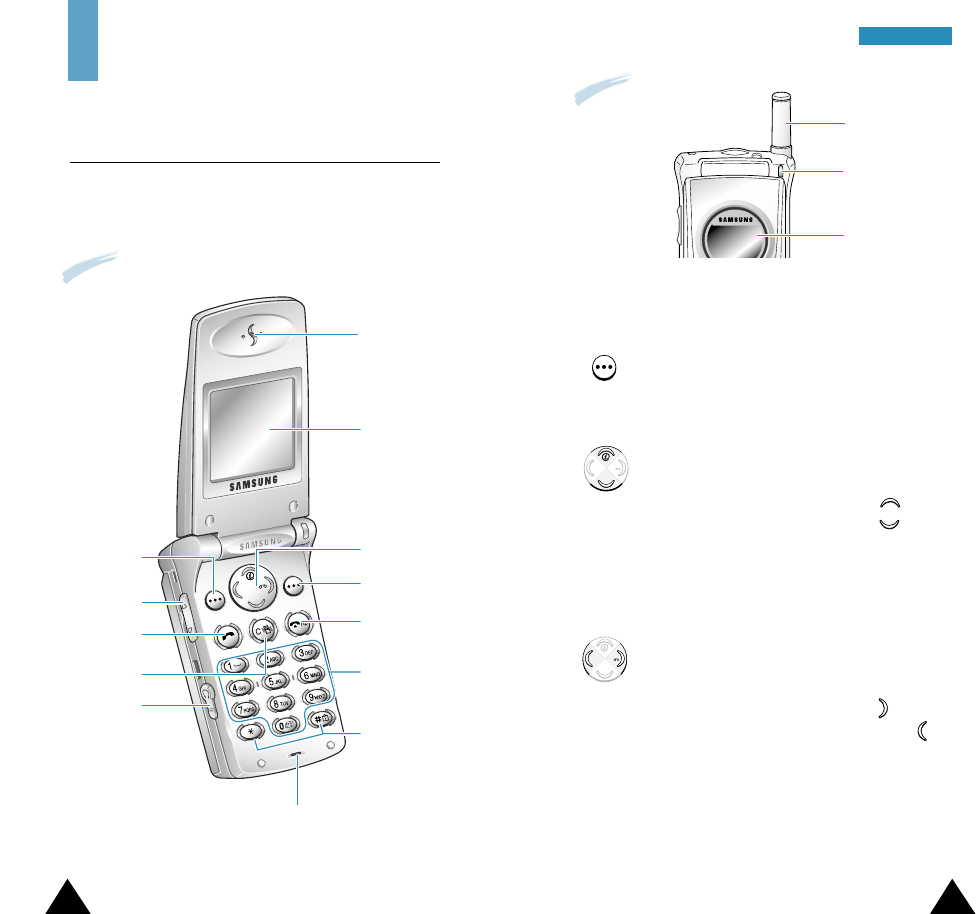
Key Description
Perform the functions indicated by the text
above them (in the bottom line of the
display).
In the menu facility, scrolls through the
menu options and phonebook memory.
When pressed in idle mode, the key
launches the WAP browser. The key
enters your favorite menu options directly
(for more information on shortcuts, see
page xx).
In the menu facility, return to the previous
menu level and select the current menu
respectively.
When pressed in idle mode, the key
enters to the Voice Memo menu. The
key enters your favorite menu options
directly (for more information on shortcuts,
see page xx).
When entering a name, move the cursor
left and right respectively.
98
YYoouurr PPhhoonnee
Earpiece
Soft key (left) Navigation key
Display
Soft key (right)
Cancel/
correction key
Power on/off key
Alphanumeric
keys
Special function
keys
Dial/menu
confirmation key
Microphone
Your Phone
Phone Layout
The following illustrations show the main elements
of your phone.
Antenna
External LCD
Ear-microphone
jock
Volume keys
(soft keys)
Service light
Closed view
Open view
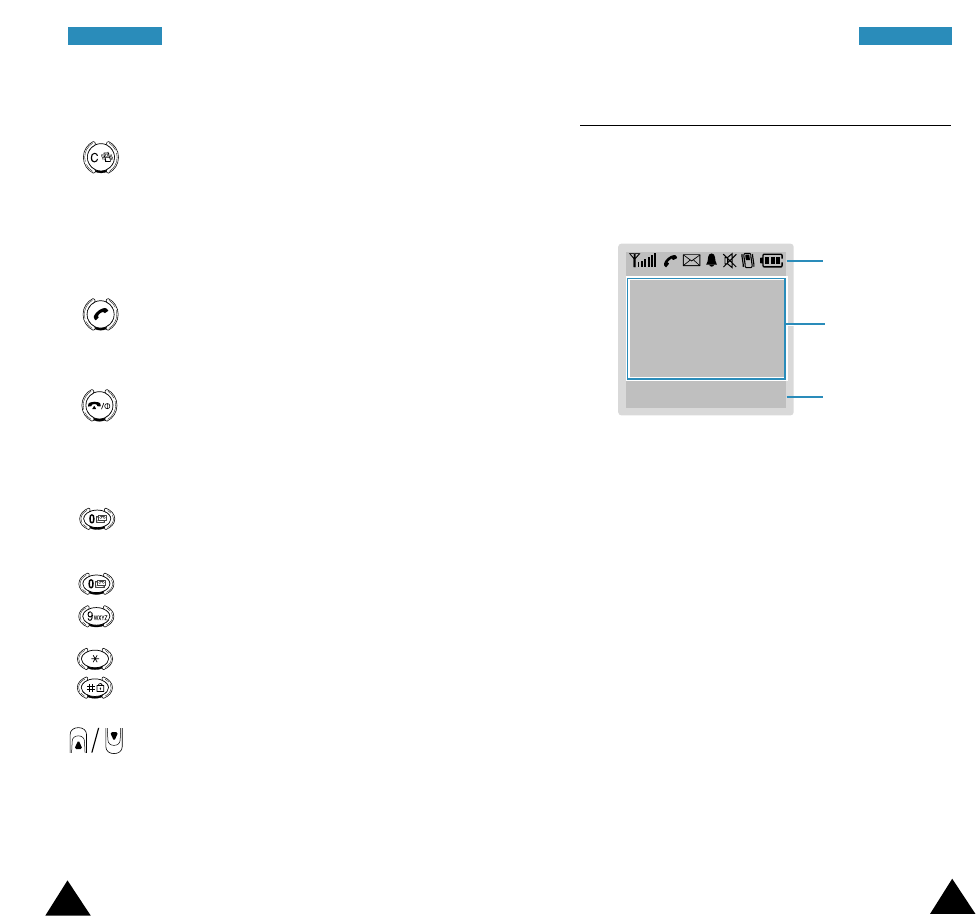
Display
Display Layout
The display comprises three areas.
Area Description
First line Displays various icons (see page xx).
Middle lines Display messages, instructions and
any information that you enter
(number to be dialed, for example).
Last line Shows the functions currently
assigned to the two soft keys.
11
10
YYoouurr PPhhoonneeYYoouurr PPhhoonnee
Key Description (continued...)
Deletes characters from the display.
In the menu facility, returns to the
previous menu level.
When held down for more than two
seconds in idle mode, quickly enters or
exits silent mode.
Makes or answers a call.
In idle mode, recalls the last number
dialed.
Ends a call. Also switches the phone on
and off when pressed and held.
In the menu facility, returns to idle mode
and cancels your input.
When held down in idle mode, allows you
to access your voice mail box.
Enter numbers, letters and some special
characters.
Enter special dial characters. Also use
these keys for various purposes in
different functions.
(on the side of the phone)
During a call, adjust the earpiece volume.
In idle mode with the folder open, adjust
the key volume.
In the menu facility, scroll through the
menu options and phonebook memory.
~
Icons
Text and
graphic area
Soft key
indications
MMeennuu NNaammeess
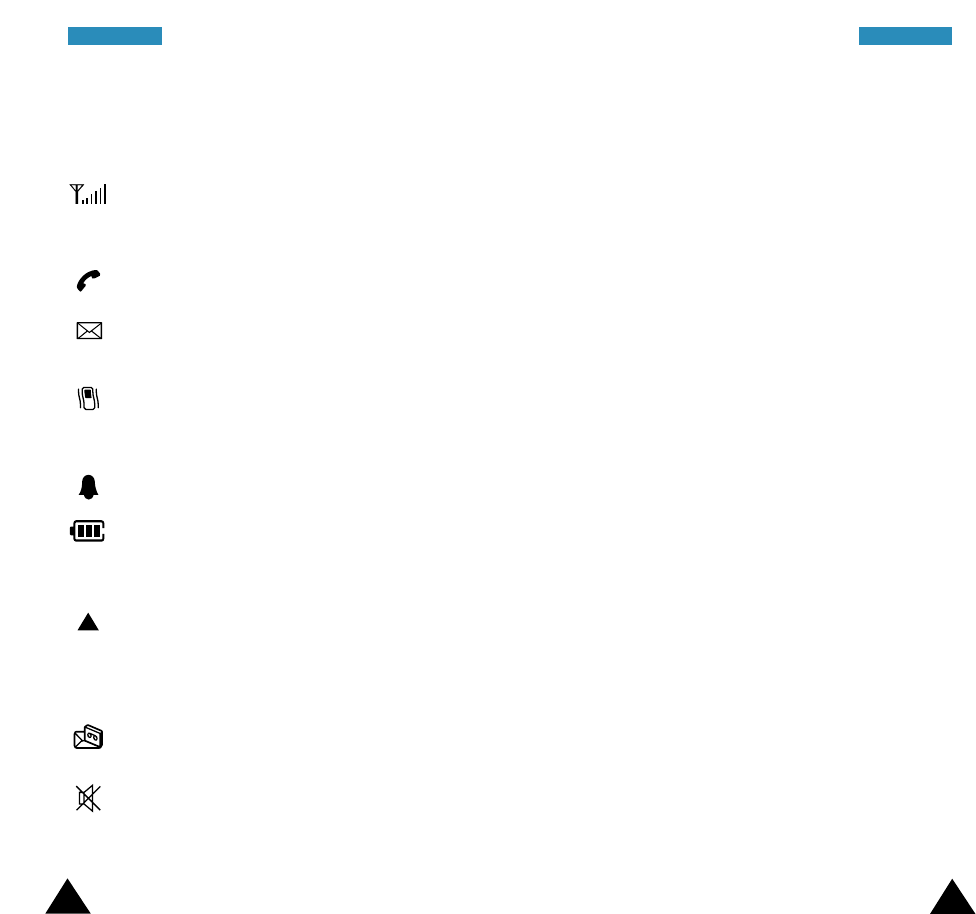
13
12
YYoouurr PPhhoonneeYYoouurr PPhhoonnee
Icons
Icon Description
Shows the received signal strength. The
greater the number of bars, the better the
signal strength.
Appears when a call is in progress.
Appears when a new text message has
been received.
Appears when the silent mode is active
and when the Alert Type menu option (3.3)
is set to Vibration.
Appears when you set the alarm.
Shows the level of your battery. The more
bars you see, the more power you have
left.
Appears when you are out of your home
area and have registered onto a different
network (when travelling in other countries,
for example).
Appears when a new voice mail message
has been received.
Appears when you activate the Mute mode.
Backlight
The display is illuminated by a backlight. When you
press any key, the backlight illuminates. It turns off if
no key is pressed within a given period of time,
depending on the Back Light option set in the
Phone Settings menu.
To specify the length of time for which the backlight
is active, set the Back Light menu option (4.2.1);
see page xx for further details.
External Display
Your phone has an external display on the cover. It
indicates that you have an incoming call or a
message, and notifies you at the specified time
when you have set an alarm.
When you press and hold down the volume keys on
the left side of the phone with the folder closed, the
backlight of the external display illuminates.
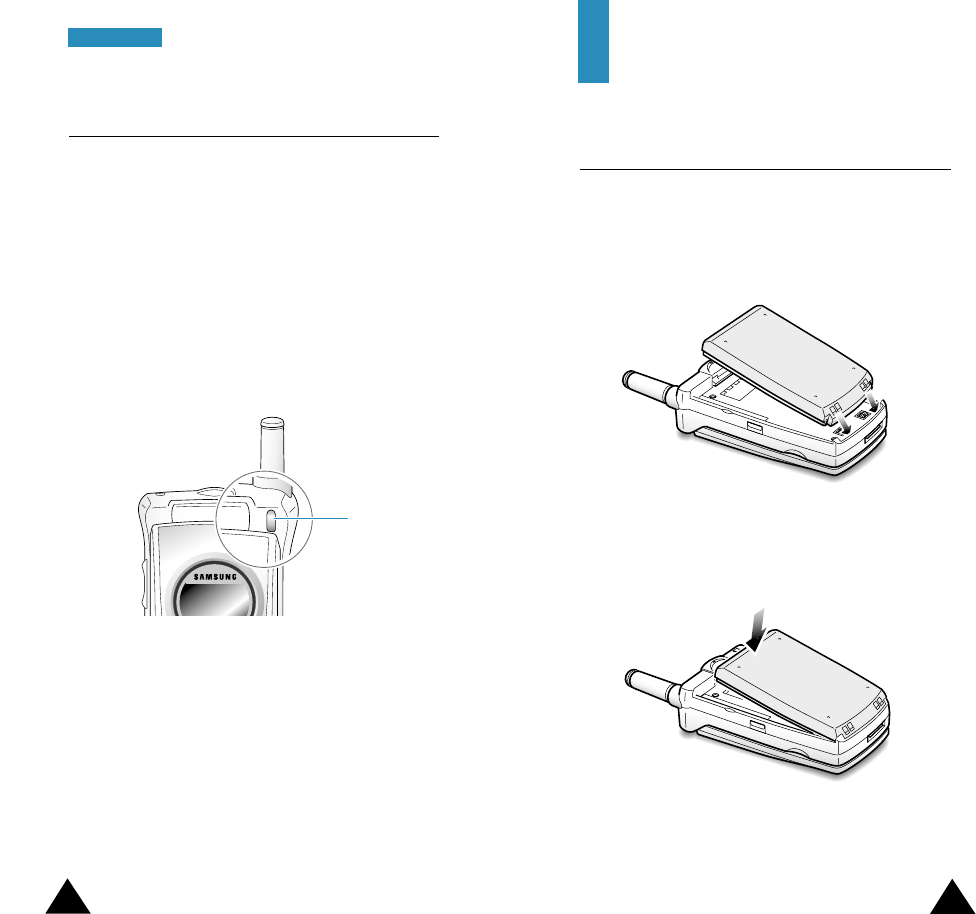
15
14
YYoouurr PPhhoonnee
Service Light
The service light is in the top right-hand corner of the
phone. It flashes to indicate phone status: It flashes
to indicate phone status: When the phone is ready
for use, it flashes in green. When a call or message
comes in, and you are recording a voice memo, it
flashes in red.
To activate or deactivate use of the service light, set
the Service Light menu option (4.3); see page xx for
further details.
Service light
Getting Started
Installing the Battery
To Install the Battery
1. Insert the contact end on the bottom of the battery
into the slots on the bottom of the phone.
2. Press the battery down until it clicks into place.
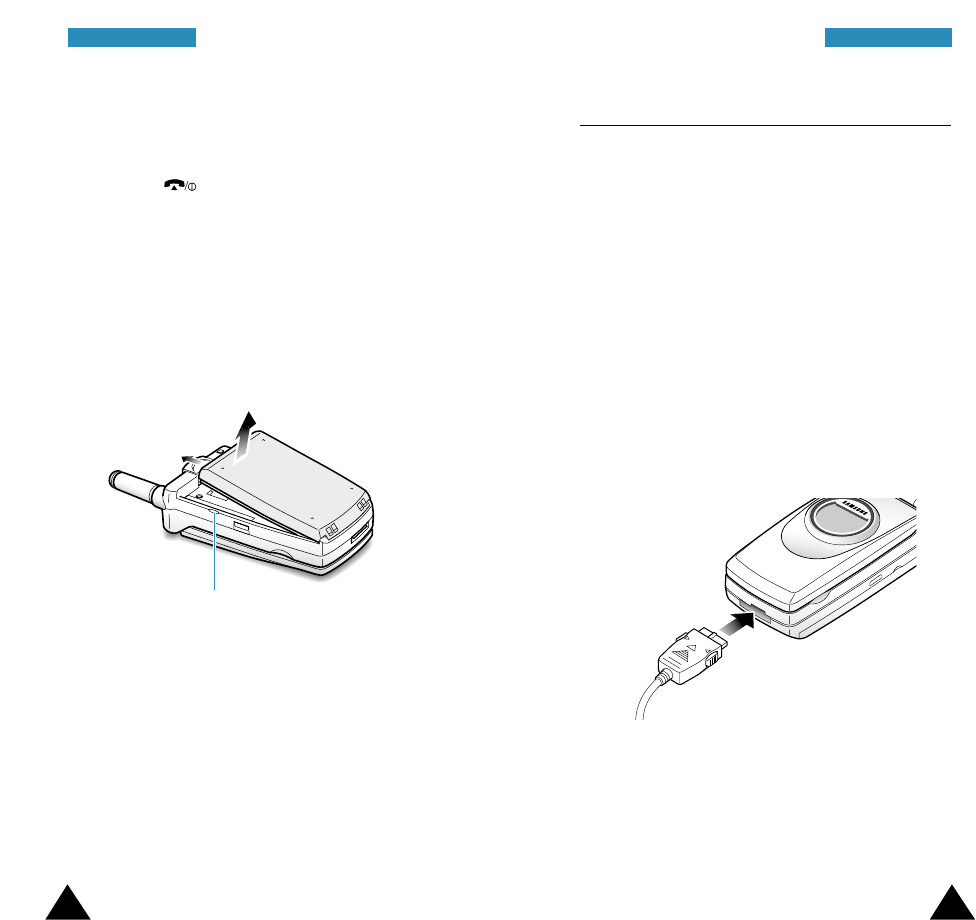
16 17
GGeettttiinngg SSttaarrtteeddGGeettttiinngg SSttaarrtteedd
13
To Remove the Battery
1. If necessary, switch off the phone by holding
down the key until the power off image
begins to play.
2. Remove the battery. To do so:
➀Push the catch toward the top of the phone
and hold it in position, then
➁lift out the battery from the phone. The
battery will easily lift out.
➁
➀
Charging a Battery
Your phone is powered by a rechargeable Li-Ion
battery. A travel charger is provided with your phone.
Use only approved batteries and chargers. Ask your
local SAMSUNG dealer for further details.
The phone can be used while the battery is charging.
Note: You must fully charge the battery before using
your phone for the first time. A discharged
battery is fully recharged in approximately
200 minutes.
1. With the battery in position on the phone, connect
the lead from the travel charger to the jack on the
bottom of the phone.
2. Connect the charger to a standard AC wall outlet.
Use this groove when
lifting the battery out.
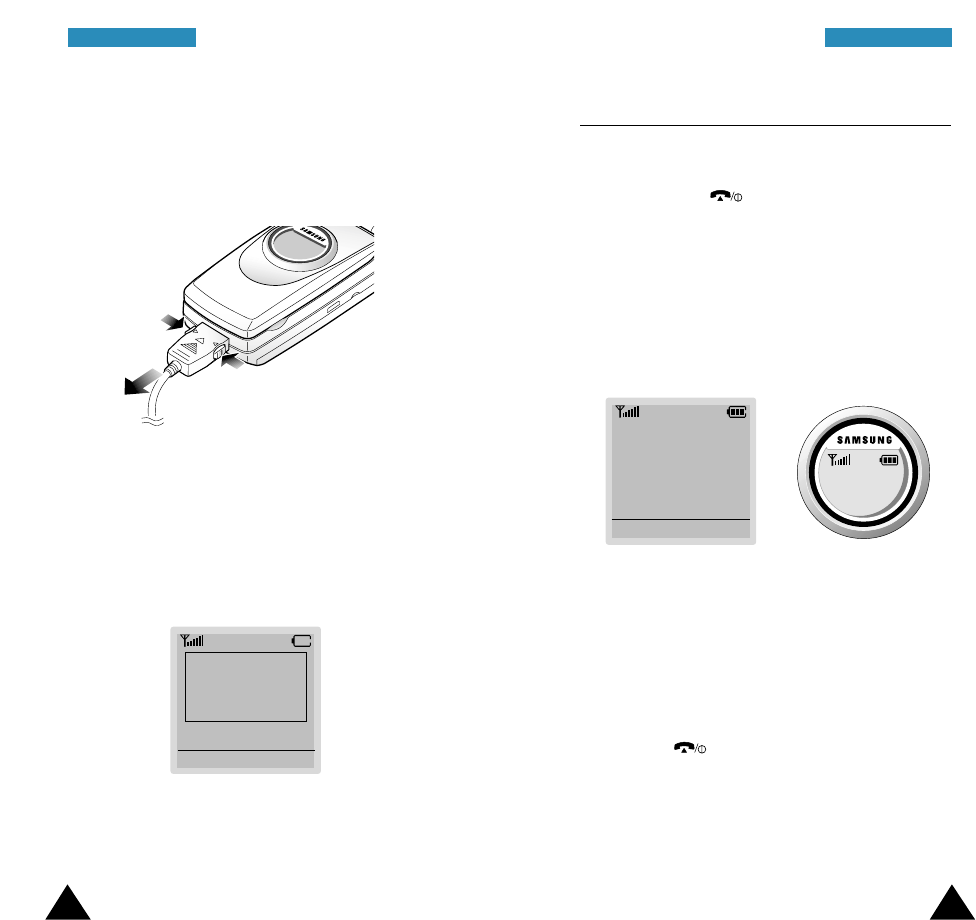
18 19
GGeettttiinngg SSttaarrtteeddGGeettttiinngg SSttaarrtteedd
3. When charging is finished (the lamp on the charge
turns green), disconnect the charger from the
power outlet and remove it from the phone by
squeezing the two tabs on the lead (➀) and unplug
the lead(➁).
Low Battery Indicator
When the battery is weak and only a few minutes of
talk time remain, you will hear a warning tone and
the following message will be repeated at regular
intervals on the display, along with the empty battery
icon:
When the battery becomes too weak for the phone
to operate, it switches off automatically.
**Warning**
Low Battery
Menu Names
➀
➀
➁
Switching the Phone On/Off
1. Open the folder.
2. Hold down the key for more than one
second to switch the phone on.
3. The phone searches for your service system and
when it finds the system, the idle screen,
illustrated below, is displayed. The external
display shows the signal strength, battery
strength and current time and date.
Note: The display language is preset to English at
factory. To change the language, use the
Language menu option (4.6); for further
details, refer to page xx.
4. When you wish to switch the phone off, hold
down the key for more than two seconds.
Service Provider
12:57P
Sat 14 Mar
Menu Names
12:57P
Sat/14
<Main display> <External display>
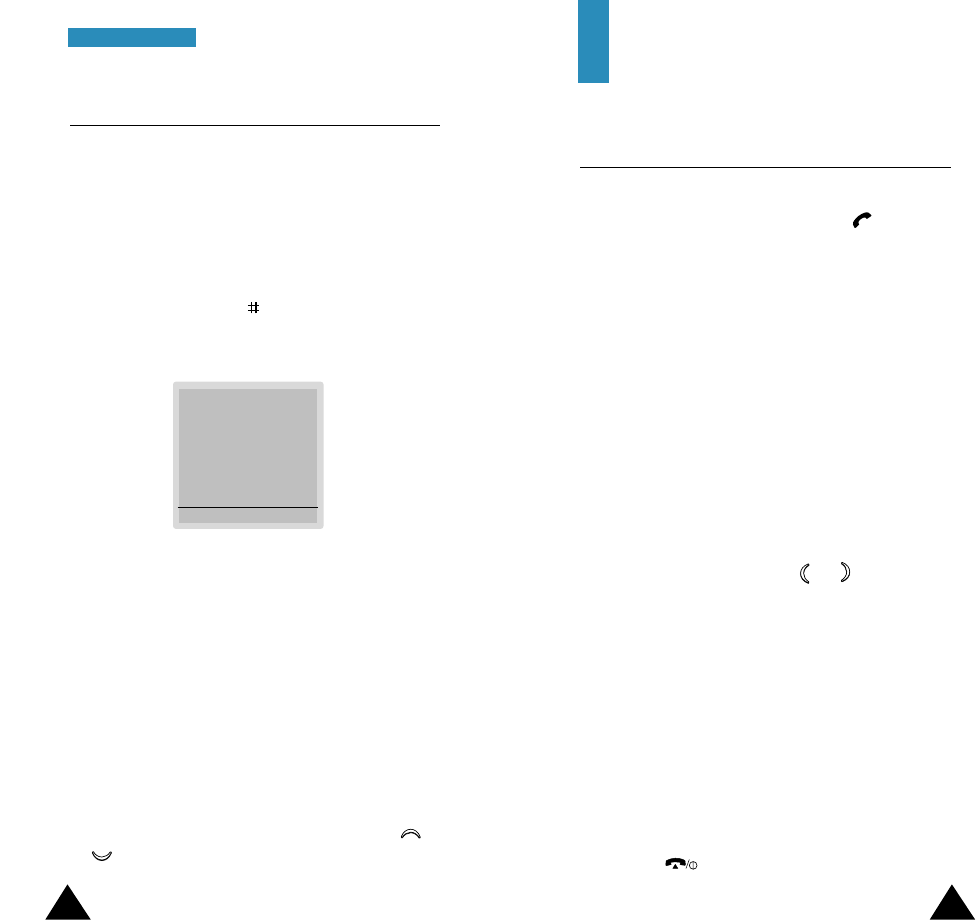
20 21
GGeettttiinngg SSttaarrtteedd
Locking Your Phone
You can lock your phone to protect the phone against
unauthorized use. When the phone is locked, you
cannot operate the phone until you enter the lock
code.
To lock your phone:
Press and hold down the key for more than two
seconds in idle mode. “Phone Locked” appears on
the idle screen.
To unlock the phone:
Press the Unlock soft key, enter the lock code, and
then press the OK soft key. Your phone’s lock code is
preset at the factory to “0000.” For further details on
the lock code, see page xx.
Even when the phone is locked, you can place an
SOS call to one of the emergency numbers stored in
the SOS Call List (6.4). See page xx for further
details.
To place an SOS call, press the SOS soft key, select
the desired emergency number by pressing the
or key and press the Yes soft key.
Service Provider
12:57P
Phone Locked
Unlock SOS
Call Functions
Making a Call
When the idle screen is displayed, key in the area
code and phone number and press the key.
Note:
If you have set the Auto Redial menu option (4.4)
to ON (see page xx) and the person called does
not answer or is already on the phone, the
number is redialed automatically up to ten times.
If the network answers the call (by voice mail
greeting, for example), the phone will not
attempt to redial.
Correcting the Number
To clear... Then press...
The last digit The Ckey.
displayed
Any other digit Press the or key until the
in the number cursor is immediately to the
right of the digit to be cleared.
Press the Ckey. You can also
insert a missing digit simply by
pressing the appropriate key.
The whole display Hold down the Ckey for more
than two seconds.
Ending a Call
When you want to finish your call, briefly press and
release the key or close the folder.
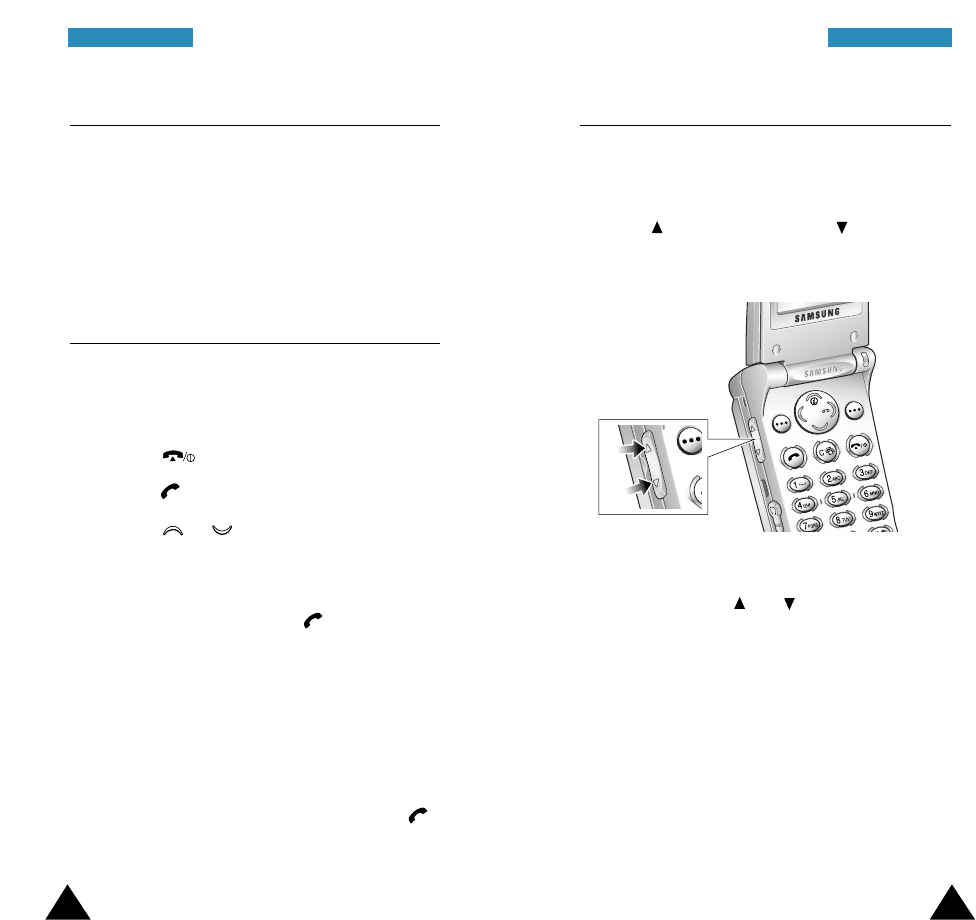
22
CCaallll FFuunnccttiioonnss
23
CCaallll FFuunnccttiioonnss
Making a Call from the Phonebook
You can store the names and phone numbers dialed
regularly in the phone memory, called Phonebook.
You then simply select the required name to recall
the associated number. For further details on the
Phonebook feature, refer to page xx.
Redialing the Last Number
The phone stores the last 10 numbers dialed. To
recall any of these numbers, proceed as follows.
1. If you have typed any characters on the display,
press the key to return to idle mode.
2.
Press the key to display the last dialed number.
3. Press the or key to scroll through the
numbers until the required number is displayed.
4. To... Then...
Dial the number Press the key.
displayed
Edit the number • Press the Edit soft key.
displayed •
Change the number as
required, referring to
“Correcting the Number”
for details (see page xx).
• Press the Save soft key to
save the number or
the
key to dial the number.
Adjusting the Volume
During a call, if you want to adjust the earpiece
volume, use the volume keys on the left side of the
phone.
Press the key to increase and the key to
decrease the volume. The more bars you see, the
louder the sound is.
In idle mode with the folder open, you can adjust the
key volume using the and keys.
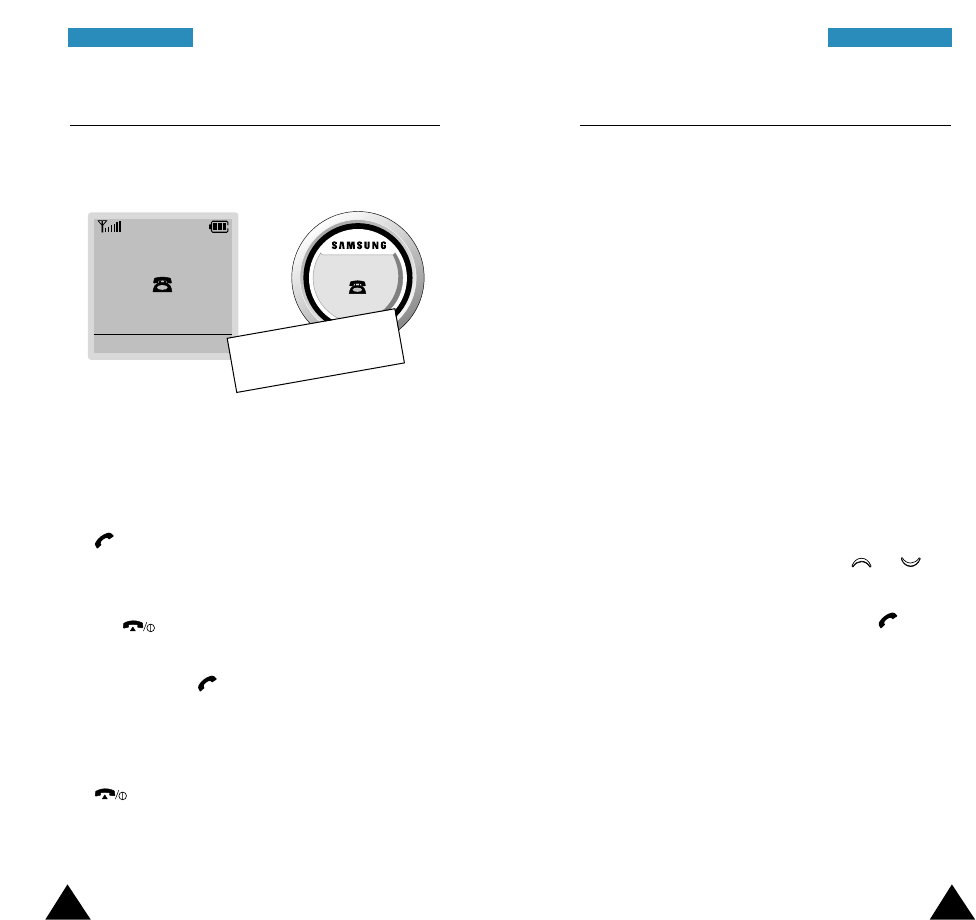
25
CCaallll FFuunnccttiioonnss
24
CCaallll FFuunnccttiioonnss
Answering a Call
When somebody calls you, the phone rings and the
phone icon in the middle of the screen flashes.
nnnnn
(( ))
If the caller can be identified, the caller’s phone
number (or name if stored in your phonebook) is
displayed. If the caller cannot be identified, only the
phone icon flashes.
1. Open the folder. If it is already open, press the
key.
If the Answer Mode menu option (4.5) is set to
Anykey Answer, you can press any key except
the key.
With the menu set to Send Key Answer, you
must press the key or the Accept soft key to
answer the incoming call (For details on the
Answer Mode menu, see page xx).
2. End the call by closing the folder or pressing the
key.
Note: You can answer a call while using the
Phonebook or menu features. The current
operation will be interrupted.
Viewing Missed Calls
If you are unable to answer a call for any reason, you
can find out who was calling you, provided that the
Caller Line Identification service is available. In this
way, you can call the person back, if necessary. The
number of missed calls is displayed on the idle
screen immediately after the call was missed.
To view the missed call immediately, take the
following steps:
1. If the folder is closed, open it.
2. Press the View soft key.
The number corresponding to the most recent
missed call is displayed, if available.
3. To... Then...
Scroll through the Press or
missed calls key.
Call the number displayed Press the key.
Edit or delete a missed Press the Options
call number soft key (see next
page).
nnnnn
(( ))
Accept
Cannot check with
the current phone.

26 27
CCaallll FFuunnccttiioonnssCCaallll FFuunnccttiioonnss
Editing a Missed Call Number
Note: If the caller’s number associated with the
missed call is not available, the Edit option is
not displayed.
1. Press the Options soft key.
2. If necessary, press the or key to highlight
the Edit option.
3. Press the Select soft key.
4. Change the number as required.
5. To... Then press the...
Call the number key.
Store the number Save soft key and enter
the name and location
required (for further
details, refer to page xx).
Deleting a Missed Call
1. Press the Options soft key.
2. If necessary, press or key to highlight the
Delete option.
3. Press the Select soft key.
You can press the key at any time to exit the
Missed Call feature.
Note: You can access the Missed Call feature at
any time by selecting the Missed Calls menu
option (1.1); for further details, see page xx.
Quick-switching to Silent Mode
You can quickly switch your phone to silent mode
with a touch of a key to mute the phone’s sound.
Press and hold the Ckey until the icon and
“Silent Mode” appears in display. Your phone goes
to silent mode immediately.
In silent mode, your phone switches the sound
settings as follows:
alert type (3.3) Vbration
message tone (3.5) Light Only
error tone (3.6) off
keypad tone off
To exit silent mode, press and hold the Ckey again
until “Exit Silent Mode” appears.
This feature is convenient when you are in a hurry to
mute the phone sound, such as when in a theater.
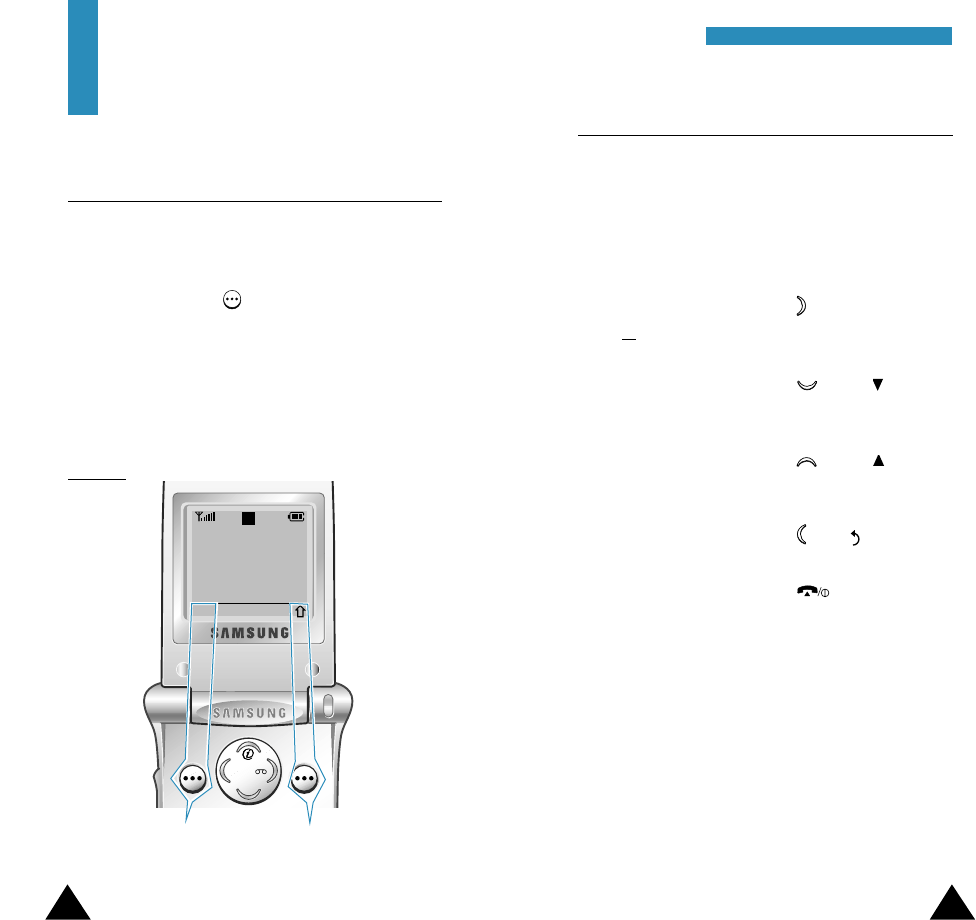
29
Selecting Functions
and Options
Using the Soft keys
Your phone offers a set of functions that allow
you to customize your phone. These functions are
arranged in menus and sub-menus, accessed via the
two soft keys marked . Each menu and sub-menu
allows you to view and alter the settings of a
particular function.
The roles of the soft keys vary according to the
current context; the label on the bottom line of the
display just above each key indicates its current role.
Example:
Press the left soft
key to save the
name entered.
Press the right soft key
to change the text input
mode.
28
Enter Name
OK
A
SSeelleeccttiinngg FFuunnccttiioonnss aanndd OOppttiioonnss
Selecting Functions and Options
To view the various functions/options available and
select the one required, proceed as follows.
1. Press the appropriate soft key.
2. To... Then press the...
Select the: Select soft key or
• Function displayed key.
or
• Option highlighted
View the next function key or key on
or highlight the next the left side of the
option in a list phone.
Move back to the key or key on
function or the left side of the
option in a list phone.
Move back up one key, soft key or
level in the structure C key.
Exit the structure key.
without changing
the settings
In some functions, you may be asked for a lock code
or security code. Enter the required code and press
the OK soft key.
Note: When you access a list of options, your phone
highlights the current option. If, however, there
are only two options, such as On/Off or
Enable/Disable, your phone highlights the
option that is not currently active, so that you
can select it directly.
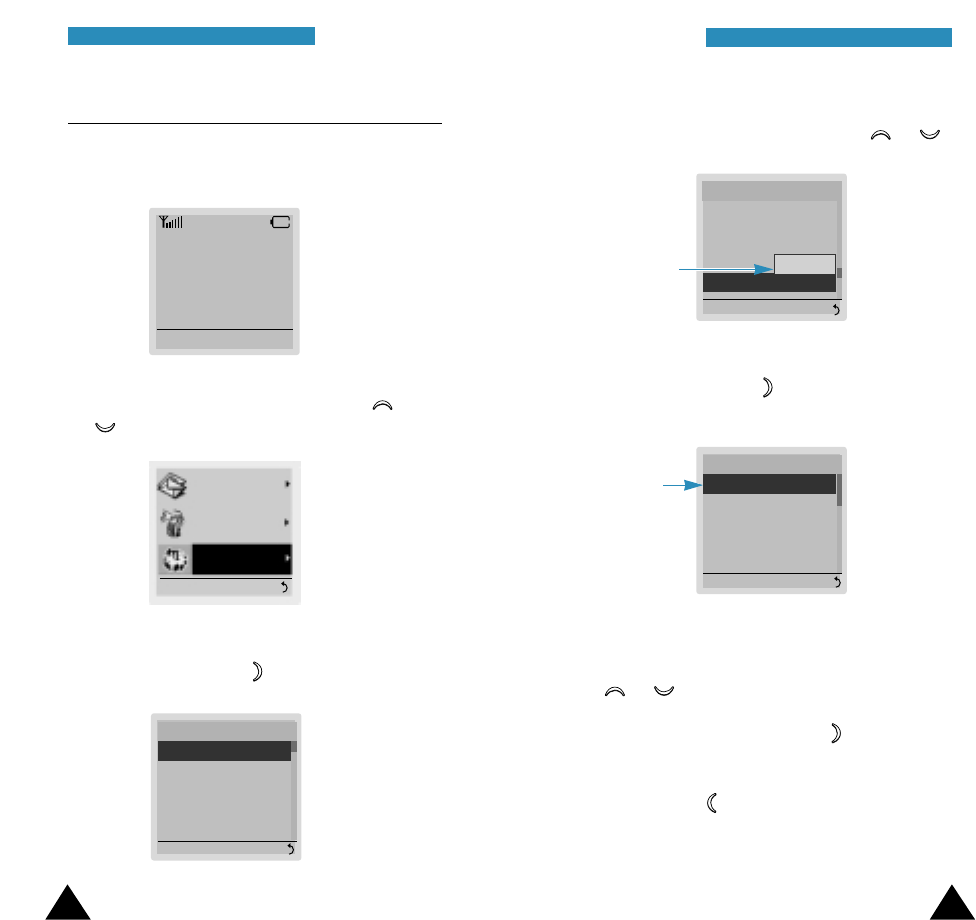
30 31
SSeelleeccttiinngg FFuunnccttiioonnss aanndd OOppttiioonnss
SSeelleeccttiinngg FFuunnccttiioonnss aanndd OOppttiioonnss
Messages
Sound
Settings
Phone
Settings
Select 4
Example: Setting the Display Language
1. When the idle screen is displayed, press the
Menu soft key to enter the menu facility.
Service Provider
10:30P
Fri 15 May
Menu Names
2. Scroll through the menus until you reach the
Phone Settings menu, by pressing the or
key.
3. To select the Phone Settings menu, press the
Select soft key or the key.
4. Scroll through the sub-menus until you reach the
Language sub-menu, by pressing the or
key.
5. To view the languages available, press the
Select soft key or the key. The current setting
is highlighted.
6. Scroll through the list of languages until the
appropriate one is highlighted, by pressing the
or key.
7. Press the Select soft key or the key to confirm
your selection.
8. Press the Cor key twice to exit the menu
structure.
Current
language
Phone Settings
1 Greeting Mess...
2 Lcd Control
3 Service Light
4 Auto Redial
5 Answer Mode
Select 4. 1
Phone Settings
2 Lcd Control
3 Service Light
4 Auto Redial
5 Answer Mode
6 Language
Select 4. 6
Language
1 English
2 Español
3 Português
Select 4.6.1
English
Current
language

32 33
Phonebook
The Phonebook allows you to store frequently used
phone numbers and the associated names in your
phone to make it easy for you to make a call without
having to remember or enter the phone number. You
can store up to 250 (1 ~ 250) entries.
Storing a Phone Number with a Name
As soon as you start to enter a number, Save appears
above the left soft key to allow you to store the
number in Phonebook.
1. Key in the number to be stored.
Note: If you make a mistake while entering a
number, correct it using the Ckey. For
further details, refer to page xx.
2. When you are sure that it is correct, press the
Save soft key.
3. Select a label by pressing the or key, and
press the Select soft key.
The available labels are: Home, Office, Mobile,
Pager, Fax, and No label.
4. Enter the corresponding name. For information on
how to enter a name, see page xx.
5. When you are satisfied, press the OK soft key.
The phone now prompts you to select a location in
the phone memory for you to save the entry.
6. If necessary, enter your preferred location by
pressing the number keys.
7. Press the OK soft key. The entry is saved and the
display shows the name and number you just
have saved.
8. Press the key to return to the idle screen.
To make a call to the displayed number, press the
Call soft key.
To access the Phonebook options, press the
Options soft key. See page xx.
Speed Dialing by Memory Location
Once you have stored phone numbers in the phone
book memory, you can dial them easily whenever you
want.
To speed dial the desired number:
For the 1-digit memory location number (1 through 9),
press and hold down the appropriate digit.
For the 2 or more-digit memory location number (10
through 250), press first digit(s) briefly and hold
down the last digit.
PPhhoonneebbooookk

34 35
PPhhoonneebbooookkPPhhoonneebbooookk
Note: If you enter the location number and press the
key, your phone displays the details on the
entry, such as name, number, location number
and label. If you have stored more than one
number for a name, scroll through the entry by
pressing the or key repeatedly.
Phonebook Options
When viewing a number in Phonebook, Options
appears above the right soft key to allow you to
access the Phonebook options.
Accessing the Options
To access the various Phonebook options, take the
following steps:
1. While viewing a Phonebook entry, press the
Options soft key. The first available option is
highlighted.
2. To... Then...
Select the Press the Select soft key.
highlighted option
Highlight a Press the or key
different option until the required option is
highlighted.
Add Number
This option allows you to store up to seven numbers
per entry by assigning them to different categories.
Note that you cannot duplicate same categories for
one entry. For example, you can only have one
number labeled “Mobile” for the selected entry.
Change Name
This option allows you to change the name for the
number. Clear the old name pressing the Ckey and
enter a new name. For information on entering a
name, see page xx.
Change Number
This option allows you to change the number. Clear
the old number by pressing the C key and enter a
new number.
Change Type
This option allows you to change the label type of a
stored number. Note that you cannot duplicate same
categories for one entry. For example, you can only
have one number labeled “Mobile” for the selected
entry.
Caller Group
This option allows you to set the number as a
member of the caller group. Select the desired caller
group from the list. For more details on the Caller
Group feature, see page xx.

36 37
PPhhoonneebbooookkPPhhoonneebbooookk
Erase Number
This option allows you to erase a stored number. If
you saved two numbers under a name, only the
currently selected number will be erased. You are
asked to confirm that you wish to erase the number
by pressing the Yes soft key.
Erase Name
This option allows you to erase a name stored in the
Phonebook so that all numbers under the name are
erased. You are asked to confirm that you wish to
erase the name by pressing the Yes soft key.
Move
This option allows you to move a Phonebook entry to
another location. When prompted, enter the location
number which you are moving the number to, and
press the OK soft key.
Set Priority NO.
This option allows you to set the selected number as
a speed dial number for the entry if it has more than
one number. Press the Set soft key .
Searching for and Dialing a Number in
the Phonebook
1. When the idle screen is displayed, press the
Names soft key. You are asked to enter a name.
2. Enter the starting characters of the name that you
want to find and press the Search soft key.
Note: You can also scroll through all Phonebook
entries by pressing the Search soft key
directly.
The Phonebook entries are listed, starting with
the first entry matching your input.
3. To... Then...
View the Press the View soft key.
highlighted entry
Select a Slide the or key
different entry until the required entry is
highlighted.
Look for a name Press the key labeled with
starting with a the required letter.
different letter
4. Once you have found the required entry, press the
key or the Call soft key to dial the number.

Name Options
While entering a name for searching, you can see
Options above the right soft key. This key allows you
to enter the various options.
Accessing the Options
To access the various Phonebook options, take the
following steps:
1. In idle mode, press the Names soft key.
2. Press the Options soft key. The first available
option is highlighted.
3. To... Then...
Select the Press the Select soft key.
highlighted option
Highlight a Press the or key
different option until the required option is
highlighted.
New Entry
This option allows you to create a new entry in the
Phonebook. For details on storing a phone number,
see page xx.
Caller Group
You can set the phone to ring in a specific way and
display a preselected graphic icon when a particular
person calls you. To do so, you must:
• Define your caller groups
• Assign the numbers in the Phonebook to the
appropriate group
38 39
PPhhoonneebbooookkPPhhoonneebbooookk
Defining a caller group
Select the group to be defined and set the
appropriate options. The following options are
available.
Call ring tone: allows you to select the ring tone to
be used when you receive a voice phone call from a
person in the group.
SMS tone: allows you to select the ring tone to be
used when you receive a text message from a person
in the group.
Graphic: allows you to select the graphic icon to be
displayed when you receive a call from a person in
the group.
Group Name: allows you to assign a name to the
group; for further details on how to enter characters,
refer to page xx.
Assigning numbers to a group
1. View the required number in Phonebook.
2. Press the Options soft key.
3. Select the Caller Group option.
4. Select the required group.
To remove a number from a group, select the No
Group option.

41
Own Number
This function is a memory aid, which you can use to
check your own phone number if you need to do so.
Memory Status
You can check the used memory and free memory
you have for Phonebook . The display shows how
many entries are currently stored and can be saved
in future in Phonebook.
Erase All
This option allows you to erase all of the Phonebook
entries.
When a confirmation appears, press the Yes soft key
to erase all Phonebook entries. To cancel erasing the
entries, press the Cancel soft key.
When prompted, enter the lock code. All entries in
the Phonebook are then erased.
40
PPhhoonneebbooookk
Entering Text
When using your phone, you will often need to enter
text. For example, when storing a name in the
phonebook, creating your personal greeting or
scheduling events in your calendar. You can enter
alphanumeric characters by using your phone’s
keypad.
You are provided with the following text input
modes.
•T9 mode
This mode allows you to enter words with only
one keystroke per letter. Each key on the keypad
has more than one letter - when you press the
key once, J, K or L may be displayed. The T9
mode automatically compares your keystrokes
with an internal linguistic dictionary to determine
the correct word, thus requiring far fewer
keystrokes than the traditional upper/lower-case
character modes.
•Upper/lower-case character modes
These modes allow you to enter letters by
pressing the key labeled with the required letter
once, twice or three times until the letter is
displayed.
•Number mode
This mode allows you to enter numbers.
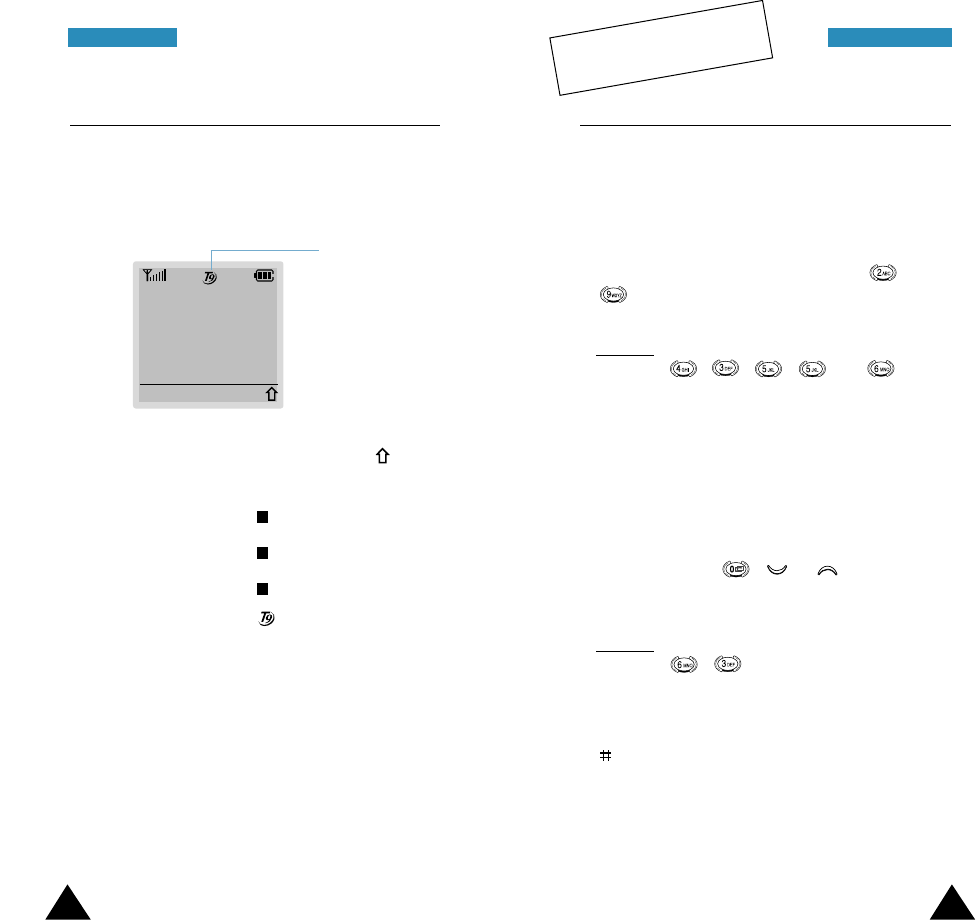
42 43
CCaallll FFuunnccttiioonnssEEnntteerriinngg TTeexxttEEnntteerriinngg TTeexxtt
Changing the Text Input Mode
When you are in a field that allows characters to be
entered, you will notice the text input mode indicator
in the display.
Text input mode
indicator
Enter Name
I
OK
To select... Then press the soft
key until...
Upper-case characters is displayed. See page xx.
Lower-case characters is displayed. See page xx.
Numbers only is displayed. See page xx.
The T9 mode is displayed. See below.
1
a
A
Using the T9 Mode
The T9 predictive text input mode allows you to key
in any character using single keystrokes. This text
input mode is based on a built-in dictionary.
1. When you are in the T9 predictive text input mode,
start entering a word by pressing keys to
. Press each key only once for one
letter.
Example: to enter HELLO in the T9 mode, press
, , , and .
The word that you are typing appears in the display.
It may change with each key that you press.
2. Enter the whole word before editing or deleting
and keystrokes.
3. If the word is correct, start entering the next word.
Otherwise, press , or repeatedly to
display alternate word choices for the keys that
you have pressed.
Example: OF and ME both share the sequence
, . The phone displays the
most commonly used choice first.
4. Complete each word with a space by pressing the
key.
• To type words not found in the T9 mode, change
the text input mode to the upper/lower-case
character input mode.
T9 mode is not available
in the current phone.
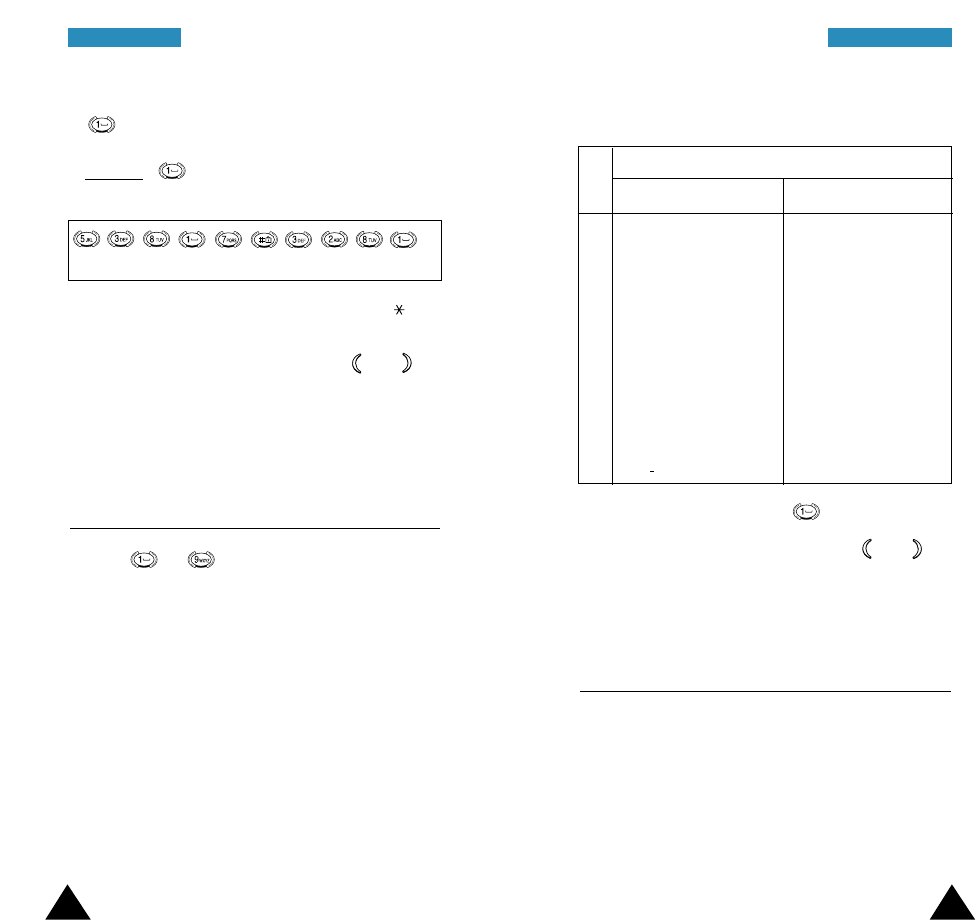
45
CCaallll FFuunnccttiioonnssEEnntteerriinngg TTeexxtt
44
EEnntteerriinngg TTeexxtt
• To enter full stops, hyphens or apostrophes, press
. The T9 mode applies grammar rules to
ensure that the correct punctuation is used.
Example: is used twice to display two
punctuation marks:
• To change the case in the T9 mode, use the
key.
• You can move the cursor by using the and
keys. To delete letters, press the C key. Press and
hold down the Ckey to clear the display.
Using the Upper/Lower-case Character
Mode
Use the to keys to enter your text.
1. Press the key labeled with the required letter:
• Once for the first letter
• Twice for the second letter
• And so on
2. Select the other letters in the same way.
Note:
The cursor moves to the right when you press a
different key. When entering the same letter
twice (or a different letter on the same key),
just wait for a few seconds for the cursor to
move right automatically, and then select the
next letter.
L E T ‘ S E A T .
Refer to the table below for more information on the
characters available using the keys.
• To insert a space, press the key.
• You can move the cursor by using the and
keys. To delete letters, press the Ckey. Press and
hold down the Ckey to clear the display.
Using the Number Mode
The Number mode enables you to enter numbers in a
text message (a telephone number for example).
Press the keys corresponding to the required digits
before manually switching back to the appropriate
text input mode.
Key Characters in the Order Displayed
Upper Case Lower Case
1
2
3
4
5
6
7
8
9
0
*
Space 1
ABC2
DEF3
GHI 4
JKL5
MNO 6
PQRS7
TUV8
WX Y Z 9
0
*/+-=<>()
%& Φ Θ Ψ Π Σ Ξ
Space 1
abc2
def3
ghi 4
jkl5
mn o 6
pqrs7
†uv8
w x y z 9
0
#.,:;!?@‘
“¿§£$¥¤ßΩ

4746
IInn--CCaallll OOppttiioonnss
Searching for a Number in the
Phonebook
You can search for a number in the Phonebook during
a call.
1. During a call, press the Options soft key.
2. Press the or key to select the
Phonebook option.
3. Press the OK soft key.
The Phonebook entries are listed.
4. Enter the name that you wish to find.
If you enter the start of the name, the Phonebook
entries are listed, starting with the first entry
matching your input. The entry is also highlighted.
5. To view the highlighted entry, press the View soft
key.
For more detailed description of the Phonebook
feature, refer to page xx.
In-Call Options
Your phone provides a number of control functions
that you can use during a call.
Muting/Sending Key Tones
You can turn the key tones which were generated
each time you press a key off or on.
To turn the key tone off, take the following steps:
1. During a call, press the Options soft key.
2. Press the or key to select the Mute
Keys option. Now, the option is replaced with
Send Keys.
3. Press the OK soft key.
Your phone does not transmit the key tones. It
allows you to press keys without hearing
annoying key tones during a call.
To turn the key tone on, take the following steps:
1. During a call, press the Options soft key.
2. Press the or key to select the Send Keys
option. Now, the option is replaced with Mute
Keys.
3. Press the OK soft key.
Note: To communicate with answering machines or
computerized telephony systems, the Send
Keys option must be selected.

48
PPhhoonneeBBooookk
49
IInn--CCaallll OOppttiioonnss
Using the SMS Service
You can create and send a SMS message during a
call.
1. During a call, press the Options soft key.
2. Press the or key to select the SMS
Service option.
3. Press the OK soft key.
4. Write text for the message, and press the OK soft
key.
5. Enter the desired phone number, and press the OK
soft key to send the message.
For further details on the SMS service, refer to
page xx.
Making a Calling Card Call
When you make a call using the prepaid calling card,
if you save the calling card information in the Calling
Card menu option (4.9), you can send automatically
the code number required for the service without
entering them manually each time you are prompted.
For further details on making a calling card call, refer
to page xx.
Making the Voice Call Private
You can make the current call private so that nobody
eavesdrops your call.
1. During a call, press the Options soft key.
2. Press the or key to select the Voice
Privacy option.
3. Press the Select soft key.
4. Press the or key to select Activate or
Deactivate.
Select Activate to secure your call or Deactivate
not to do.
5. Press the Select soft key.
Putting a Call on Hold
You can make another call while you have a call in
progress if this service is supported by the network.
Of two calls, one is active and the other is on hold
and you can swap between the calls.
Note: The procedure to put a call on hold may vary
depending on your network. For further details,
contact your service provider.

To make a call while you have a call in progress, take
the following steps:
1. During a call, key in the phone number that you
wish to dial or look it up in Phonebook.
2. Press the key to dial the second call. The first
call is automatically put on hold.
3. To swap between the two calls, simply press the
key.
4. To end the current call, press the key.
Answering a Second Call
You can answer an incoming call while you have a
call in progress, if this service is supported by the
network and you have set the Call Waiting menu
option (7.2) to Activate (see page xx). You will be
notified of an incoming call by a call waiting tone.
To answer a call while you have a call in progress,
take the following steps:
1. When you hear a call waiting tone, press the
key to answer the incoming call.
The first call is automatically put on hold.
2. To switch between the two calls, press the
key.
3. To end the current call, press the key.
50 51
IInn--CCaallll OOppttiioonnssIInn--CCaallll OOppttiioonnss
Making a 3-way Conference Call
You can conduct conference calls with two separate
parties at the same time. A conference call is a
network service. For more information, contact your
service provider.
Note: The procedure may vary depending on your
network. Contact the service provider for
details.
1. Call the first participant in the normal way.
2. Call the second participant in the normal way.
The first call is automatically put on hold.
3. When the second person answer, press the
key to merge the calls.
4. End the conference call by closing the flip cover
or pressing the
key
.
During a conference call, if one of the callers hangs
up, you and the remaining caller will stay connected.
If you initiated the call and you hang up first, all
three parties are disconnected.
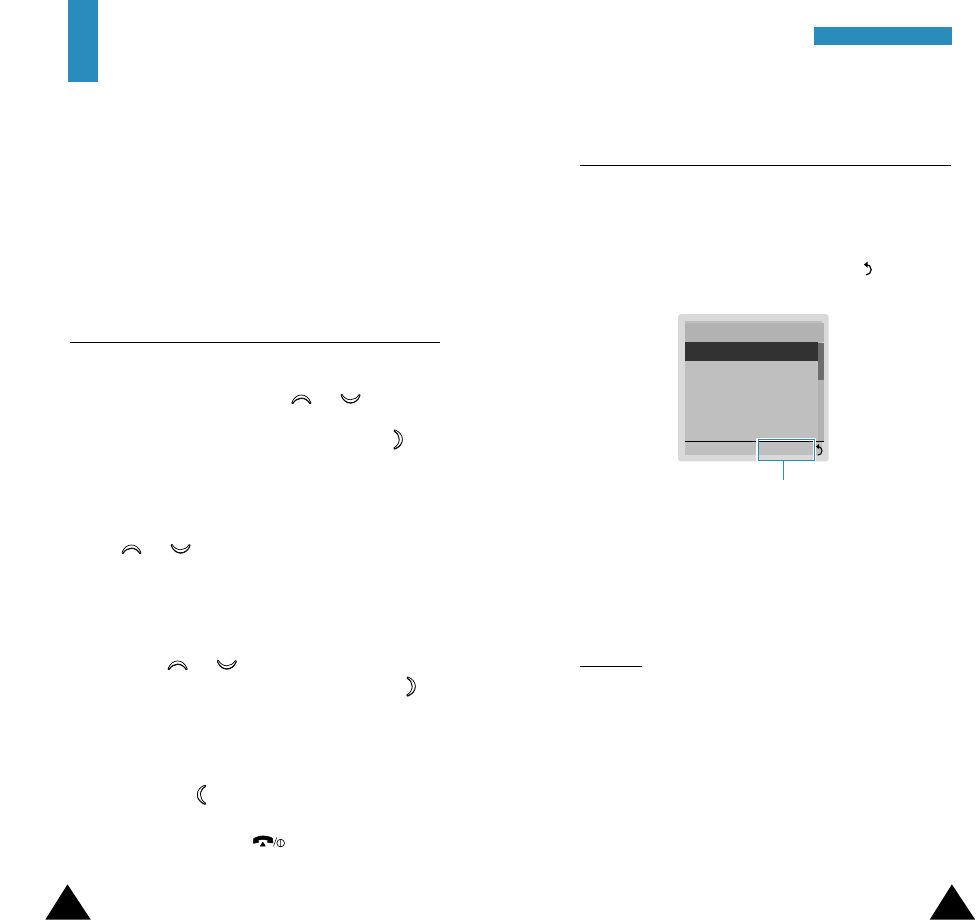
Accessing a Menu Function by Using its
Shortcut
The menu items (menu, submenus and setting
options) are numbered and can be accessed quickly
by using their shortcut number. The shortcut number
is shown in the bottom right next to the soft key
on the display.
1. In idle mode, press the Menu soft key.
2. Within three seconds, key in the first digit of the
shortcut number. Repeat this for each digit of the
shortcut number.
Example: Setting the Backlight option to Short
Press the Menu soft key, and key in 4, 2, 1, 2.
Menu for entering the menu, 4for Phone
Settings, 2for LCD Control, 1for Backlight, 2
for Short .
Note: The numbers assigned to each menu function
are indicated on the list on page xx.
5352
Using the Menus
The phone offers a range of functions that allows
you to customize the phone to your needs. These
functions are arranged in menus and submenus.
The menus and submenus can be accessed by
scrolling or by using the shortcuts.
Accessing a Menu Function by Scrolling
1. In idle mode, press the Menu soft key to access
the menu facility. Press the or key to
reach the desired main menu, e.g., Phone
Settings. Press the Select soft key or the key
to enter the menu.
2. If the menu contains any submenus, for example,
Language, find the one you want by pressing
the or key. Press the Select soft key to
enter the submenu.
If the menu you selected has submenus, repeat
this step.
3. Press the or key to find the setting of
your choice. Press the Select soft key or the
key to confirm the chosen setting.
Notes:
• You can return the previous menu level by pressing
the Ckey or the key.
• You can exit the menu without changing the menu
settings by pressing the key.
UUssiinngg tthhee MMeennuuss
Backlight
1 Off
2 Short
3 Long
Select 4.2.1.1
Shortcut number
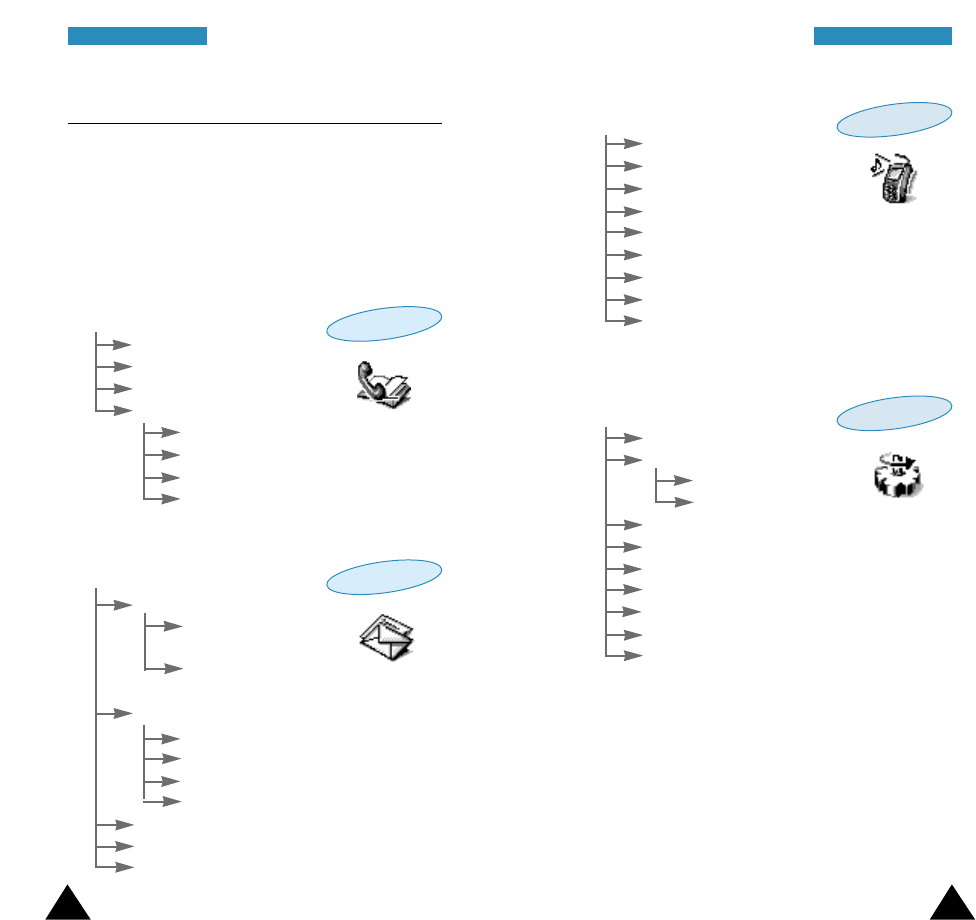
List of Menu Functions
The following illustration shows the menu structure
available and indicates the:
• Number assigned to each option
• Page on which you can find a description of each
feature
54 55
UUssiinngg tthhee MMeennuussUUssiinngg tthhee MMeennuuss
1.1 Missed Calls
1.2 Incoming Calls
1.3 Outgoing Calls
1.4 Call Time
1.4.1 Last Call Time
1.4.2 Total Call Time
1.4.3 Display Call Time
1.4.4 Reset Timers
1. Call Records
Page xx
2. Messages
2.1 Voice Mail
2.1.1 Connect to
Voice Server
2.1.2 Voice Server
Number
2.2 Read Messages
2.2.1 New Inbox
2.2.2 Old Inbox
2.2.3 Outbox
2.2.4 Delete All
2.3 Write Messages
2.4 Preset Message List
2.5 Setup
Page xx
3. Sound Settings
3.1 Ring Volume
3.2 Ring Tone
3.3 Alert Type
3.4 Tone Length
3.5 Message Tone
3.6 Error Tone
3.7 Minute Minder
3.8 Connect Tone
3.9 Melody Composer
4. Phone Settings
4.1 Greeting Message
4.2 LCD Control
4.2.1 Back Light
4.2.2 Contrast
4.3 Service Light
4.4 Auto Redial
4.5 Answer Mode
4.6 Language
4.7 Reset Settings
4.8 Calling Card
4.9 Shortcut
Page xx
Page xx
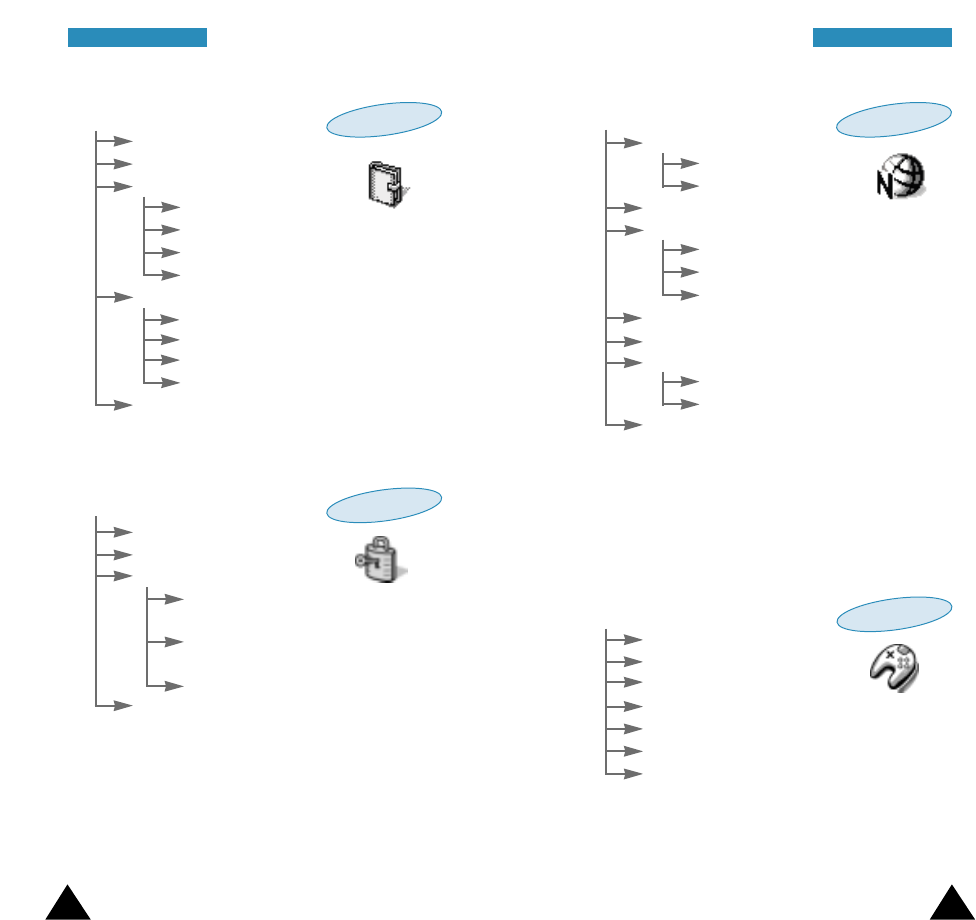
56 57
PPhhoonneeBBooookkUUssiinngg tthhee MMeennuussUUssiinngg tthhee MMeennuuss
6. Security
6.1 Change Lock Code
6.2 Change Security Code
6.3 Call Restriction
6.3.1 restrict all
outgoing call
6.3.2 restrict all
incoming call
6.3.3 restrict outgoing call
6.4 SOS Call List
Page xx
5. Organizer
5.1 Calendar
5.2 To Do List
5.3 Time & Date
5.3.1 Set Time
5.3.2 Set Date
5.3.3 World Time
5.3.4 Format
5.4 Alarm
5.4.1 Once Alarm
5.4.2 Daily Alarm
5.4.3 Weekly Alarm
5.4.4 Remove Alarm
5.5 Calculator
Page xx
7. Network Services
7.1 Call Diverting
7.1.1 Divert Always
7.1.2 Busy
7.2 Call Waiting
7.3 Network Selection
7.3.1 Automatic
7.3.2 Manual
7.3.3 New Search
7.4 Voice Privacy
7.5 NAM Selection
7.6 Set Service Code
7.6.1 Call Diverting
7.6.2 Call Waiting
7.7 Public System Selection
8. Games
8.1 Casino
8.2 Roulette
8.3 Black Jack
8.4 Sniper
8.5 Snake
8.6 Mole
8.7 Othello
Page xx
Page xx
*2
*1
*1
*1 available when you set the service code in the Set
Service Code menu option (7.6).
*2 may be unavailable depanding on the service provider.
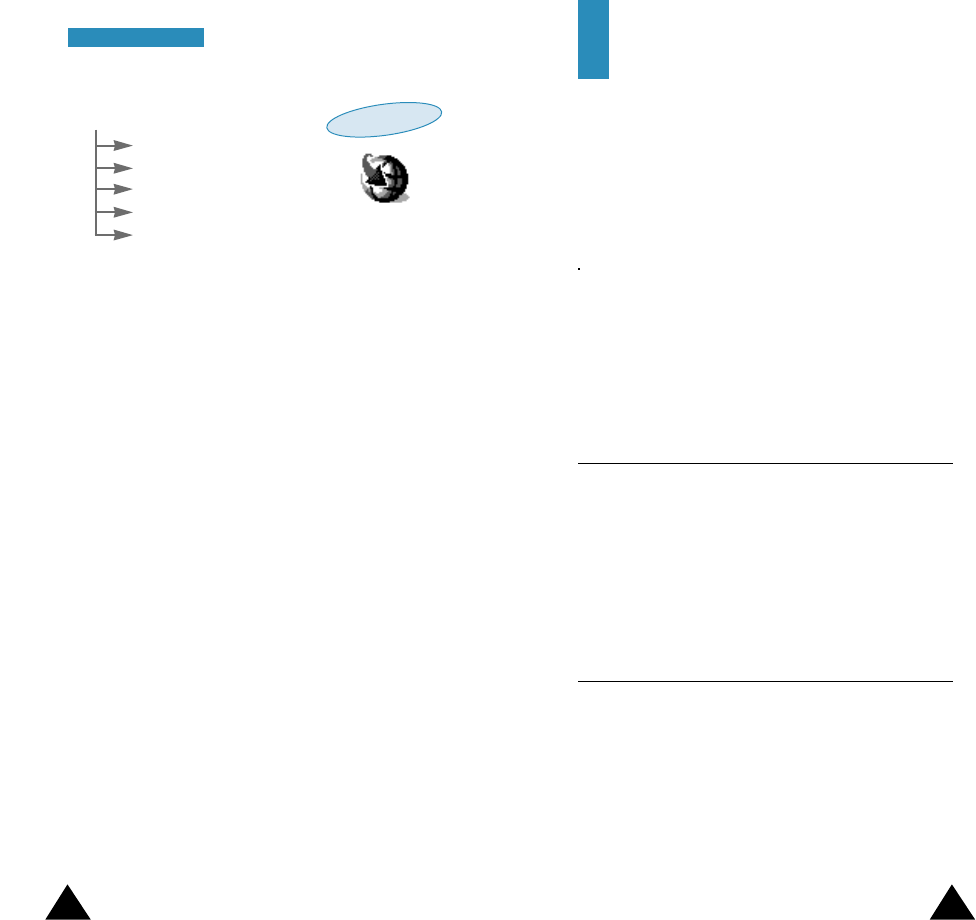
58 59
UUssiinngg tthhee MMeennuussCall Records
Via this menu, you can view the following phone
calls:
• Missed
• Incoming
• Outgoing
The number and name (if available) are displayed,
together with the date and time at which the call was
made.
Note: Your phone can keep up to ten numbers in
each record.
Missed Calls Menu 1.1
This option lets you view the last unanswered calls.
Pressing the Options soft key allows you to:
• Edit the number (if available) and dial it or save it
in Phonebook
• Delete the call from the list
Incoming Calls Menu 1.2
This option lets you view the last calls received.
Pressing the Options soft key allows you to:
• Edit the number (if available) and dial it or save it
in Phonebook
• Delete the call from the list
9. WAP Browser
9.1 Home
9.2 Favorite
9.3 http://
9.4 Settings
9.5 Clear Cache
For details on the WAP browser feature, refer to the WAP
Browser guide supplied with your phone.
Page xx

61
CCaallll RReeccoorrddss
60
Outgoing Calls Menu 1.3
This option lets you view the last numbers dialed.
Pressing the Options soft key allows you to:
• Delete the number
• Edit the number and save it in Phonebook
Call Time Menu 1.4
This option lets you view the timers for calls made
and received. The following timers are available.
Last Call Time: duration of the last call.
Total Call Time: total duration of all calls made
from or receive to your phone since the timer was
last reset using the Reset Timer option.
Display Call Time: allows you to set the phone to
display the call time when the call is made or
received. Select Enable to display the call time and
Disable not to display it.
Reset Timers: option used to reset the call timers;
you must first enter the phone’s security code (see
page xx) and then press the OK soft key.
Note: The actual time invoiced for calls by your
service provider may vary, depending on
network features, rounding-off for billing
purposes and so forth.
Messages
The SMS (Short Message Service) function is a
network service and may not be supported by your
network. Messages can be sent by text, fax and e-
mail messaging systems, provided that these services
are supported by your network.
When you receive new text messages, the icon
appears on the top line of the display. If the message
memory is full, an error message is displayed and you
cannot receive any new messages. Use the Delete
All option in the Read Messages menu (2.2) to
delete obsolete messages.
Voice Mail Menu 2.1
This menu provides you with a way of accessing your
voice mailbox (if provided by your network).
Note: Please contact your service provider for more
information. Depending on the service
provider, you may be charged for accessing
the voice server.
Connect to Voice Server: Before using this
feature, you must enter the voice server number
obtained from your service provider (see menu
option 2.1.2). You can then select this option to listen
to your voice mails.
Note: You can connect to the voice mail server of
the service provider quickly by pressing and
holding down the key in idle mode.

6362
Voice Server Number: allows you to change the
voice mail server number.
To... Then press the...
Enter the server number Corresponding numeric
keys.
Correct a digit Ckey.
Save the entered number Save soft key.
Read Messages Menu 2.2
Three message boxes are available:
New Inbox: used to store the messages that you
have received but not read.
Old Inbox: used to store the messages that you have
received and read.
Outbox: used to store the messages that you have
already sent or will send.
1. Select the required box. The first message in the
box is displayed with the following information:
• Message number
• Message status: New, Old, Not Sent, Sent
(If you have set the Delivery Ack menu option
to ON, the report is also shown; see page xx for
further details.)
•
Date and time at which the message was
received (Inboxes only)
MMeessssaaggeessMMeessssaaggeess
2. Press the or key to select the message
you want to read.
3. To view this message, press the View soft key.
The screen shows the:
• Sender’s phone number (if the message was
sent) or recipient’s phone number
• Message text
To scroll through the message, press the or
key. You can choose the following options, by
pressing the Options soft key.
Delete: allows you to delete obsolete messages.
Text Reply: allows you to reply by sending a text
message.
Call Back: allows you to call the sender back.
Cut Number: allows you to extract a number from
the message text, so that you can call the number or
save it in Phonebook.
Send: allows you to send a message that you have
received or saved. You can:
• Send the message
• Save and send the message
• Save but not send the message
Edit And Send: allows you to edit a message for
sending.
Note: The available options may vary, depending on
the message status (New/Old, Not Sent or
Sent for example).
To delete all messages, you can select Delete All
(Menu 2.2.4).

65
MMeessssaaggeess
64
MMeessssaaggeess
Write Messages Menu 2.3
Via this menu, you can write a text message of up to
160 alphanumeric characters and send it to multiple
destinations. For further information on how to enter
the characters in your message, see page xx.
1. Press the or key to select a setting group
on which you have set up default information on
the SMS feature via the Setup menu (see the
page xx), and press the Select soft key.
2. After completing the message, press the OK soft
key.
Note: While writing a message, pressing the
key allows you to start new line.
3. Select the desired one of the following options by
pressing the or key, and press the Select
soft key.
• Send Only: After transmission, the message
will be cleared.
• Save and Send: allows you to save a copy of
the message. When you read the message in
your outbox, Sent is displayed to indicate the
message status.
• Save Only: allows you to save the message so
that it can be sent later. You do not take the
next step. When you read the message in your
outbox, Not sent is displayed.
4. Select an Empty cell for the destination (phone
number or e-mail address) by pressing the or
key and press the Edit soft key.
5. Enter the desired destination and press the OK
soft key.
Note: The Names soft key visible when you do not
enter anything allows you to search for a
number in your Phonebook.
6. If you want to send the message to multiple
destinations, repeat steps 4 and 5 as needed.
To delete an entered destination, select the
desired one, and press the Delete soft key.
7. When entering destinations is done, press the
key to send the message.
Preset Message List Menu 2.4
Using this menu, you can preset up to five messages
that you send most frequently to retrieve when
writing a new message. Scroll through the list by
pressing the or key. When the required
message number appears, press the Options soft
key.
The following options are available:
Edit: allows you to write a new message or edit the
selected preset message.
Note: For further information on how to enter the
characters, refer to page xx.
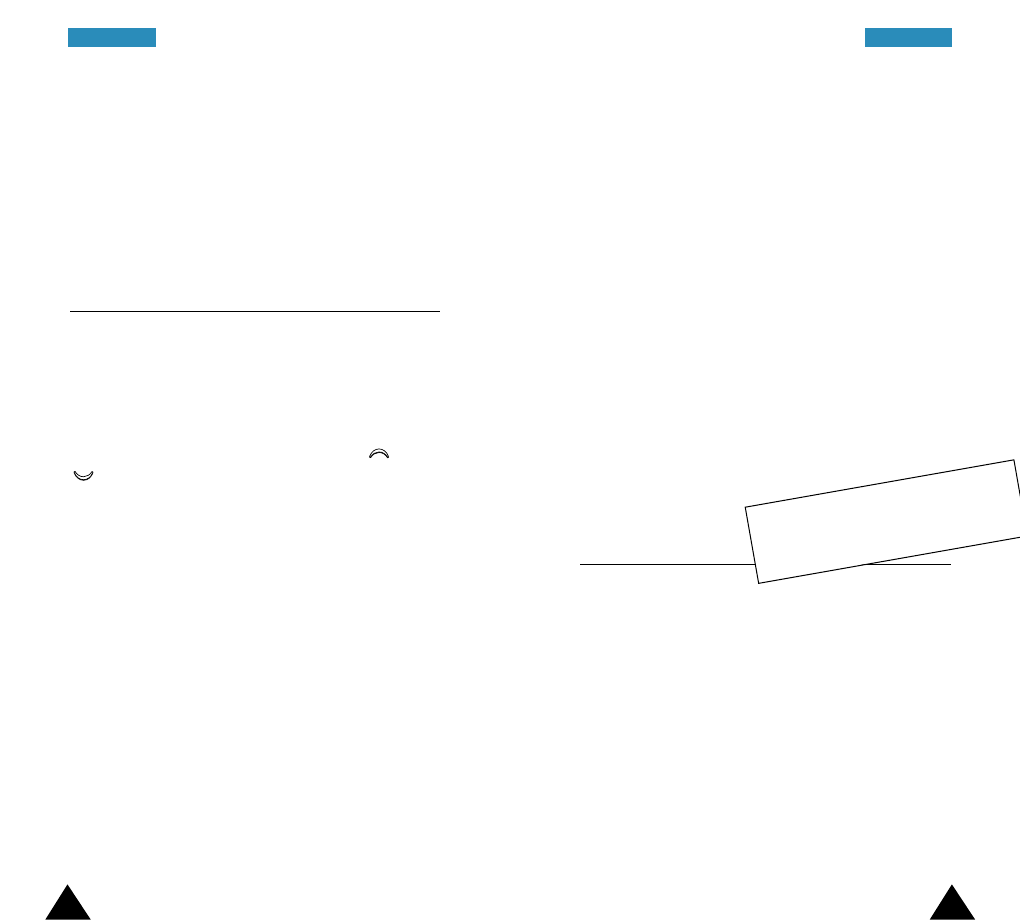
6766
MMeessssaaggeessMMeessssaaggeess
Send Message: allows you to retrieve the selected
message for sending. Once you have completed the
message, you can send, save and send, or simply save
it.
Delete: allows you to delete the selected message.
Setup Menu 2.5
Via this menu, you can set up default information for
the SMS feature. A setting group is a collection of
settings required to send messages. Five setting
groups are available.
Select the desired number by pressing the or
key, and press the key or the Select soft key.
Then, set up the options for the group.
The available setup options are:
Setting Name: allows you to give a name to the
setting group currently being defined.
Callback Number: allows you to set the phone
number to which the recipient of your SMS message
may send you a reply message via your message
center, if the service is provided by the network.
Manual Ack: allows you to activate or deactivate
the manual acknowledgement function. When this
function is activated, the recipient can send you an
answer to your message by one touch of a number
key.
Delivery Ack: allows you to activate or deactivate
the delivery acknowledgement function. When this
function is activated, the network informs you
whether your message has been read or not by the
recipient.
Privacy: allows you to set the restriction feature.
When this option is set to Restricted, the recipient
must have the password which you have set when
writing a message to see the message. If you do not
want to use the feature, select Not Restricted.
Urgency: allows you to set the urgency status of the
messages. Bulk, Normal, Urgent, and Very Urgent
are available.
Type: allows you to set the type of messages. The
available types are; Text and E-mail.
Picture Message Menu 2.6
In this menu, you can send an SMS message
containing pictures. Your phone have 10 preset
pictures that can be replaced with pictures received
from other sources, such as the internet or remote
phones.
Select the desired picture from the list and press the
View soft key. When the picture is displayed, press
the Options soft key. The following options are
available:
Delete: deletes the picture from the phone. The
preset picture will be restored.
This menu is not shown in the
current phone. The contents are
from SGH-Q200.

6968
Receiving Pictures, Ring Tones, or
Operator Logos
When you receive a message from other phones or
from the Internet, you will hear an alert beep and a
text notification will appear on the display: Picture
Message, Ring Tone or Operator Logo. You have the
option of saving these items in the phone’s memory
or discarding them.
Picture Message
You may send the received picture as and SMS
message to another phone that supports this feature.
You may save up to 10 pictures.
When you receive a picture message:
To... Then...
View the picture Press the View soft key.
Save the picture • Press the Options soft
key.
• Select Save Picture, and
press the Select soft key.
• Select a preset picture to
be replaced, and press the
Select soft key.
Discard the • Press the Options soft
picture key.
• Select Discard, and press
the Select soft key.
Use the saved Go to page xx.
picture
Text Reply*: allows you to send a text reply to the
sender of the selected picture.
Call Back*: allows you to call the sender back.
Cut Number*: allows you to extract a number from
the message, so that you can call the number or save
it in the phonebook.
Send: allows you to send the picture message using
the selected picture. Note that the recipient's phone
must support the Picture Messaging feature.
Edit Text*: allows you to edit text from the
message.
Rename: allows you to change the title of the
picture. For details on entering characters, see page
xx.
Notes:
• Picture messages are stored in the phone memory.
You cannot view them if you use your SIM card in
another phone.
• Each picture message is made of several text
messages. Therefore, sending one picture
message may cost more than sending one text
message.
*: unavailable when the selected picture is one of the preset pictures.
MMeessssaaggeessMMeessssaaggeess
This feature is not available in
the current phone. The contents
are from SGH-Q200.

7170
Operator Logo
The new operator logo will be displayed in place of
the service provider’s name on the idle screen when
you are connected to the corresponding network. You
may save only one Operator Logo. Each time you save
a new logo, the old one is deleted.
When you receive an operator logo message:
To... Then...
View the logo Press the View soft key.
Save the logo • Press the Options soft
key.
• Select Save, and press
the Select soft key.
Discard the logo • Press the Options soft
key.
• Select Discard, and press
the Select soft key.
Ring Tone
You may set the received tone as your phone’s ring
tone. You may save up to 10 tones.
When you receive a ring tone message:
To... Then...
Listen to the • Press the Options soft
ring tone key.
• Select Playback and
press the Select soft key.
• Press the Stop soft key to
stop playing back.
Save the ring tone • Press the Options soft
key.
• Select Save and press the
Select soft key.
• Select a location and press
the Select soft key.
• Select the Yes or No soft
key when the phone asks
if you want to set the ring
tone to the received tone.
Discard the • Press the Options soft
message key.
• Select Discard, and press
the Select soft key.
Use the saved Go to page xx.
ring tone
MMeessssaaggeessMMeessssaaggeess

73
SSoouunndd SSeettttiinnggss
72
Alert Type Menu 3.3
This option allows you to indicate how you are to be
informed of any incoming calls. The following options
are available.
Light Only: only the backlight is switched on; the
phone neither rings nor vibrates.
Melody: the phone rings using the ringer tone
selected via the Ring Tone menu option (3.2).
Vibration: the phone vibrates but does not ring.
Vibra+Melody: the phone first vibrates three times
and then starts ringing.
Step Melody: the phone rings using the selected
ringer tone, but the volume becomes louder and
louder from the minimum level. Reaching to the
maximum, the phone restarts from the minimum.
Tone Length Menu 3.4
The tone length setting enables you to select Short or
Long DTMF (dual-tone multi-frequency) tones. DTMF
tones are what your phone transmits to access
teleservices (such as a bank account). The system used
by the bank or other service determines if you need
short or long DTMF. If the service is digital (which most
are these days), short DTMF will almost always work.
However, some new systems and almost all older
(analog) system require you to use long DTMF tones.
Sound Settings
You can use the Sound Settings feature to customize
various settings, such as the:
• Ringing tone or melody, volume and type
• Sounds made when you press a key, make an
error or receive a message
Ring Volume Menu 3.1
This option allows you to adjust the volume level of
the ringer.
Press the or key to increase or decrease the
level. You can also use the or key on the left
side of the phone. The greater the number of bars
you see, the greater the volume is.
Ring Tone Menu 3.2
This option allows you to select the desired ringer
tone. You can choose from 23 different tones. Each
time you select a tone, it sounds for a few seconds.
Tones 19 and 20 correspond to the melodies that you
can compose, using the Melody Composer menu
option (3.9), and 10 additional options are ring tone
received from the other sources (web or remote
phones). (????)

7574
Minute Minder Menu 3.7
This option allows you to specify whether the phone
must beep every minute during an outgoing call to
keep you informed of the length of your call.
The following options are available:
OFF: the phone does not beep.
ON: the phone beeps every minute.
Connect Tone Menu 3.8
You can set your phone to beep when your call is
connected to the remote phone (or the remote phone
is ringing depending on your network).
The following options are available:
OFF: the phone does not beep.
ON: the phone beeps when your call is connected.
Message Tone Menu 3.5
This option allows you to select how the phone
informs you that a new message has been received.
The following options are available:
Light Only: the service light in the top right-hand
corner of the phone flashes.
Single Beep: the phone beeps once.
SMS Tone1~10: the phone uses an SMS tone. You
are provided with ten SMS tones.
Error Tone Menu 3.6
This option allows you to select how the phone
informs you that you have made a mistake.
The following options are available:
OFF: the phone does not beep.
ON: the phone beeps to indicate an invalid entry.
SSoouunndd SSeettttiinnggssSSoouunndd SSeettttiinnggss

7776
To... Then press the...
Listen to your Listen soft key.
melody
Modify your Modify soft key.
melody
Saving a Melody
When you are satisfied with your melody after
listening to it, you can save the melody and indicate
that you wish to use it as the ring tone.
1. Press the Save soft key.
2. Enter a title for the melody, and press the OK soft
key.
Note: For further details on how to enter
characters, refer to page xx.
You are asked if the melody is to be set as the ring
tone.
3. To use the melody as the ring tone, press the Yes
soft key. The melody is saved and set to the
current ring tone.
Otherwise, press the No soft key. The melody is
saved only.
Note: You can also select the melodies composed via
the Ring Tone menu option (3.2); they are tones
19 and 20 respectively.
Melody Composer Menu 3.9
This option allows you to compose your own melody
to be used as the ring tone.
Three octaves are available. A maximum of 100 notes
can be entered. You can adjust the length of the
notes and add rests, as required.
Composing a Melody
You can compose two melodies. When you access
the menu, the names of any melodies created are
displayed. Otherwise, Melody 1 and Melody 2 appear.
Select the melody that you wish to create or edit.
To... Then press the...
Compose a Edit soft key.
melody
Insert a note Next soft key.
Move a note a key.
semitone up
Move a note a key.
semitone down
Change the
key one or more times until
length of a note the note is of the required length.
Delete a note Ckey.
Enter a rest key
one or more times
for the
required length of time.
SSoouunndd SSeettttiinnggssSSoouunndd SSeettttiinnggss

7978
PPhhoonnee SSeettttiinnggss
Phone Settings
Many different features of your phone can be
customized to suit your preferences via the Phone
Settings menu.
Greeting Message Menu 4.1
This option allows you to set a greeting to be
displayed briefly when the phone is switched on. The
current message is displayed.
To... Then press the...
Clear the existing Ckey and hold it down until
message the message is cleared.
Enter a new Appropriate alphanumeric
message keys.
For further details on how to
enter characters, refer to page
xx.
Save the message OK soft key.
LCD Control Menu 4.2
Back Light
You can select whether or not the phone uses the
backlight. A marginal increase in standby/talk time can
be achieved by turning the backlight off.
The following options are available:
OFF: the backlight is not used.
Short: the backlight comes on when you press a key
or receive a call and switches off 10 seconds after
the last key is pressed.
Long: the backlight comes on when you press a key
or receive a call and switches off 20 seconds after
the last key is pressed.
Contrast
This option allows you to adjust the contrast of the
LCD screen by pressing the or key. You can
also use the or key on the left side of the
phone. Each time you slide the key, you can see the
LCD screen changing according to the current value.
Service Light Menu 4.3
This option allows you to select whether or not the
service light in the top right-hand corner of the phone
is used.
The following options are available:
OFF: the service light is not used.
ON: the service light flashes when the phone is
ready for use.

8180
Auto Redial Menu 4.4
With the Auto Redial function, the phone makes up
to ten attempts to redial a phone number after an
unsuccessful call.
Note: The interval between two call attempts varies
depending on the network.
The following options are available:
OFF: the number is not redialed.
ON: the number is redialed automatically.
Answer Mode Menu 4.5
This option allows you to select how incoming calls
are to be answered.
The following options are available:
Open Answer: to answer a call, you can simply
open the folder. When it is already open, pressing
the key answers the call.
Any Key Answer: to answer a call, you can press
any key except the key. Pressing the key
mutes the ringer.
Send Key Answer: to answer a call, you must press
the key. Pressing the key mutes the ringer.
Language Menu 4.6
You can select a display language. The available
language options are: English, Español, and
Português.
Reset Settings Menu 4.7
You can easily reset the menu settings to its factory
default status.
Enter the 4-digit security code and press the OK soft
key. The phone immediately resets all settings to
default status.
Note: The security code is preset to “0000.” To
change this code, refer to page xx.
Calling Card Menu 4.8
When you use a calling card for long distance calls,
you must send the service code and the card number
to the calling card service system. Using this menu,
you can save these calling card information to send
them automatically when you make calling card calls.
You can store up to five calling cards.
Enter 4-digit security code and press the OK soft key
to access the Calling Card menu.
PPhhoonnee SSeettttiinnggssPPhhoonnee SSeettttiinnggss

8382
Selecting a Calling Card
You can set the default card to use for making a
calling card calls. The number stored in the selected
card will be sent when you make calling card calls.
1. Scroll to the desired calling card by pressing the
or key, and press the Select soft key.
2. Select Set Default by pressing the or key,
and press the Select soft key.
3. The display shows the number saved for the calling
card. If you are satisfied, press the Set soft key.
4. To return to idle mode, press the key.
Making Calls Using the Calling Card
Note: The procedure may not apply to all calling
cards. Please look at the back of your calling
card or contact your phone company for
instructions.
1. Make a call to the calling card service system.
2. When you are connected, press the Options soft
key and select Callcard Service by pressing the
or key.
3. Press the OK soft key.
4. When you hear the prompting tone from the
service system, press the key to transmit the
card numbers.
5. Dial the number of the desired remote phone.
Saving Calling Card Information
1. Scroll to a calling card number by pressing the
or key, and press the Select soft key.
2. If you want to set the card name, press the Select
soft key. Enter the name as needed.
For further details on entering characters, see page
xx.
3. When entering name is finished, press the OK soft
key. The name is saved.
4. Press the key to move to the Card Number
menu, and press the Select soft key.
5. Enter the card number (and/or PIN if required) as
listed on the back of the calling card.
To enter a pause, “P” before the second number,
press and hold the key. The number after “P”
will be sent only by pressing the key when you
make a call with the calling card.
Note: The order of the numbers which you must
enter may vary depending on the dialing
sequence your card uses.
6. When entering the number is finished, press the
OK soft key.
7. To return to idle mode, press the key.
PPhhoonnee SSeettttiinnggssPPhhoonnee SSeettttiinnggss

8584
Organizer
The Organizer feature enables you to:
• View the calendar and organize your schedule
• Define a list of things to do
• Set the current date and time
•
Set the alarm so that the phone rings at a specific
time (to remind you of an appointment for example)
• Use the phone as a calculator
Calendar Menu 5.1
With the Calendar feature, you can:
• Consult the calendar
• Write memos to keep track of your schedule and
trigger an alarm if necessary
Consulting the Calendar
When you select the Calendar menu option (5.1), the
calendar is displayed. The following options are
available when you press the Options soft key:
Search all: displays all memos set, regardless of the
day and starting with the oldest. To scroll through the
memos, press the or key.
Delete all: allows you to delete all memos. You are
asked to confirm your selection.
Go to date: allows you to jump to a specific date.
Shortcut Menu 4.9
The navigation key can also be used as shortcut keys.
When slid or pressed in idle mode, it allows you to
access specific menu options directly.
Using this menu, the following menu options can be
assigned to the shortcut keys:
• Calendar (Menu 5-1)
• Calculator (Menu 5-5)
• Messages (Menu 2)
• Sound Settings (Menu 3)
• Games (Menu 8)
• To Do List (Menu 5-2)
• Phonebook (with the entries listed by name)
• New Inbox (Menu 2-2-1)
1. Select the key to be used as a shortcut key by
pressing the or key, and press the Select
soft key:
•Key down
•Key left
Note: The and keys are fixed to enter the
WAP Browser and Voice Memo menus
respectively.
2. Select the menu option to be assigned to the key
by pressing the or key, and press the
Select soft key.
Note: To deactivate a shortcut key, select the None
option.
PPhhoonnee SSeettttiinnggss

87
OOrrggaanniizzeerr
Once you have finished editing the memo, press the
OK soft key. The following options are available
when you press the Options soft key:
Alarm: allows you to set the alarm to ring on the
chosen day.
Erase: allows you to delete the memo.
Copy to: allows you to copy the memo to another
date.
Move to: allows you to change the date and time of
the memo.
New: allows you to write a new memo.
To Do List Menu 5.2
This feature allows you to:
• Draw up a list of tasks to be done
• Assign a priority and deadline to each task
• Sort the tasks by priority and status mark ( for
tasks to be done, ✓for completed tasks)
Creating the To Do List
To create the To Do List, take the following steps:
1. Press the New soft key.
2. Enter the first task.
Note: For further details on how to enter
characters, see page xx.
3. Press the OK soft key.
Writing a Memo
To write or edit a memo on a specific date, take the
following steps:
1. Select the required date in the calendar, by
pressing the navigation keys.
Note: Press the key to skip to the previous
month or the key to skip to the next
month.
2. Press the Select soft key.
An empty memo screen is displayed to allow you to
enter your memo.
3. Enter your memo and then press the OK soft key.
Note: For further details on how to enter
characters, refer to page xx.
You are asked if you wish to set the alarm.
4. If you want the alarm to ring on the chosen day,
press the Yes soft key.
Otherwise, press the No soft key.
5. If you pressed Yes, set the time for the alarm and
press the OK soft key.
A check mark is displayed in front of the date in the
calendar to indicate that a memo exists.
Editing a Memo
If you select a day for which a memo already exists,
you can press the Edit soft key to edit the memo
displayed.
Note: For further details on how to enter characters,
refer to page xx.
86
OOrrggaanniizzeerr

89
OOrrggaanniizzeerr
88
OOrrggaanniizzeerr
To... Then...
Sort the existing • Press the Options soft key.
tasks by priority • Select the Sort option.
or status • Select the sort criterion (High,
Low, Done, Undo).
Copy a task • Highlight the task.
• Press the Options soft key.
• Select the Copy option.
• Change the text, priority and
deadline for the task as
required.
Delete a task • Highlight the task.
• Press the Options soft key.
• Select the Delete option.
Delete all tasks • Press the Options soft key.
• Select the Delete all option.
• Confirm the deletion by
pressing the OK soft key.
Time & Date Menu 5.3
This option allows you to change the current time
and date displayed. You can also check the current
time for Greenwich Mean Time (GMT) and 21 major
cities around the world.
Set Time: allows you to enter the current time. You
can choose the time format via the Format menu
option (5.3.4).
4.
Select High or Low priority by
pressing the or
key
, and press the Select soft key.
5. Enter your deadline. If you do not want to define
the deadline, press the Skip soft key.
6. Press the OK soft key to save the task.
Editing the To Do List
If tasks are already defined in the To Do List when you
select the To Do List menu option (5.2), the current
contents are displayed with the associated priority
and status mark. The following options are available:
To... Then...
View the details • Highlight the task.
for a specific task • Press the View soft key.
Change the status • Highlight the task.
of a specific task • Press the key to mark the
( or ✓) task as completed as of the
current date and time.
or
• Highlight the task.
• Press the Options soft key.
• Select the Mark option.
• Select the appropriate status.
Create a new task • Press the Options soft key.
• Select the New option.
• Enter the text, priority and
deadline for the task.
Edit an existing • Highlight the task.
task • Press the Options soft key.
• Select the Edit option.
• Change the text, priority and
deadline for the task.

9190
Note: Before setting the time, you must specify your
time zone, via the World Time menu option
(5.3.3).
Set Date: allows you to enter the day, month and
year. You can change the date format via the Format
menu option (5.3.4).
World Time: allows you to check the current time
for Greenwich Mean Time (GMT) and 21 major cities
around the world, by pressing the or key.
The screen shows the:
• City name
• Current date and time
• Time difference between the selected city and
your city if you have set the local time (see below
for further details) or GMT (by default)
To select the time zone in which you are located,
take the following steps:
1. Select the city corresponding to your time zone by
pressing the or key.
The local date and time are displayed.
2. Press the Set soft key.
Format: allows you to change the time and date
formats.
Time format: 24 Hours
12 Hours
Date format: YYYY/MM/DD (year/month/day)
DD/MM/YYYY (day/month/year)
MM/DD/YYYY (month/day/year)
Alarm Menu 5.4
You can set the alarm to ring at a specific time.
Note: To meet FAA safety guidelines, the alarm does
not function when the phone is off.
The following frequency options are available.
Once Alarm: the alarm rings only once and is then
deactivated.
Daily Alarm: the alarm rings every day at the same
time.
Weekly Alarm: the alarm rings every week on the
same day and at the same time.
To set the alarm, take the following steps:
1. Choose the alarm frequency option and press the
Select soft key.
2.
Enter the required time and press the OK soft key.
3. If you select Weekly alarm in step 1, select the
day of the week and the OK soft key.
To stop the alarm when it rings, open the folder and
press the Exit soft key.
Remove Alarm: deactivates the alarm.
OOrrggaanniizzeerrOOrrggaanniizzeerr

9392
Calculator Menu 5.5
Using this feature, you can use the phone as a
calculator. The calculator provides the basic arithmetic
functions; addition, subtraction, multiplication and
division.
1. Enter the first number using the numeric keys.
2. Press the right soft key until the required
arithmetic symbol appears: +(add), -(subtract),
*(multiply), /(divide).
3. Enter the second number.
4. Repeat steps 2 to 3 as many times as required.
Notes:
• To erase any mistakes and clear the display,
press the Ckey.
•
To include a decimal point or a bracket, press the
left soft key until the required symbol is displayed.
5. To calculate the result, press the key.
6. To end the calculation, press the key.
OOrrggaanniizzeerrSecurity
The Security feature enables you to restrict the use
of your phone to:
• The people of your choice
• The types of calls of your choice
Change Lock Code Menu 6.1
The lock code is a password for locking or unlocking
the phone. The lock code is preset to “0000” at
factory. This menu allows you to change your current
lock code to a new one.
Before you can specify a new lock code, you must
enter the current code. Then, enter a new code and
enter it again to confirm.
Change Security Code Menu 6.2
The security code is used for restriction of the use of
your phone. The security code is preset to “0000” at
factory. This menu allows you to change your current
security code to a new one.
Before you can specify a new security code, you
must enter the current code. Then, enter a new code
and enter it again to confirm.

9594
SSeeccuurriittyySSeeccuurriittyy
Call Restriction Menu 6.3
The call restriction feature allows you to restrict your
calls.
Call restriction can be set up in the following ways:
restrict all outgoing call: calls cannot be made.
restrict all Incoming call: calls cannot be
received.
restrict outgoing call: calls to the phone numbers
which you have specified cannot be made. You can
set up to 10 phone numbers.
To restrict the all outgoing or all incoming calls, take
the following steps:
1. Select restrict all outgoing call or restrict all
incoming call by pressing the or key,
and then press the Select soft key.
2. Select Enable to the feature on, and press the
Select soft key.
If you want to set the restriction off, select
Disable.
3. Enter your security code and press the OK soft
key.
To set the phone numbers to be restricted, take the
following steps:
1. Select restrict outgoing call by pressing the
or key, and then press the Select soft key.
2. Enter your security code and press the OK soft
key.
3. Select an empty location by pressing the or
key, and press the Options soft key.
4. Select Edit, then the OK soft key. If a number has
already been saved, this option allows you to edit
the number.
If you want to erase a saved number, select
Erase. When a confirmation displays, press the
Yes soft key.
5. Enter the phone number and press the OK soft
key. The phone number is saved and now you
cannot make a call to the number.
SOS Call List Menu 6.4
Your phone provides emergency numbers for SOS
calls programmed by the service provider. Three
numbers can be manually dialed at any time even
when the phone is locked or all outgoing calls are
restricted.
To make an SOS call when the phone is locked, press
the SOS soft key, select the desired number saved in
the SOS call list, and then press the Call soft key.

96 97
3. Enter the number to which the calls are to be
diverted, and press the OK soft key.
Note: The Names soft key visible when you do not
enter anything allows you to search for a
number in your Phonebook.
The phone sends your setting to the network and
the network’s acknowledgement is displayed.
You can deactivate each call diverting setting by
selecting the Cancel option.
Call Waiting Menu 7.2
This network service enables you to be informed when
someone is trying to reach you during another call.
Note: For using the Call Waiting service, you must
set the service code for it. Depending on the
Set Service Code setting, this menu may not
appear. For details, see page xx.
The following options are available:
Activate: activates the Call Waiting feature. You can
answer an incoming call while you have a call in
progress. See page xx for answering a waiting call.
Cancel: deactivates the Call Waiting feature.
Network Services
These menu functions are network services.
Please contact your service provider to check their
availability and subscribe to them, if you so wish.
Call Diverting Menu 7.1
Note: For using the Call Diverting service, you must
set the service code for it. Depending on the
Set Service Code setting, this menu may not
appear. For details, see page xx.
This network service enables incoming calls to be
rerouted to the number that you specify.
Example: You may wish to divert your business calls
to a colleague while you are on holiday.
Call diverting can be set up in the following ways:
1. Select the type of the call diverting options by
pressing the or key, and press the Select
soft key.
• Divert Always: all calls are diverted.
• Busy: calls are diverted if you are already making
another call.
2. When Activate is highlighted, press the Select
soft key.
NNeettwwoorrkk SSeerrvviicceess

9998
NNeettwwoorrkk SSeerrvviicceessNNeettwwoorrkk SSeerrvviicceess
Voice Privacy Menu 7.4
Used only in digital networks, Voice Privacy encrypts
the voice channel so that people cannot eavesdrop
on your call conversation. If you turn this feature on
and voice privacy becomes inactive for any reason
your phone displays “Voice privacy not active” and
beeps.
The following options are available:
Activate: turns this feature on. Your calls will be
secured.
Deactivate: turns this feature off.
Note: This feature may not be available in all areas.
Contact your service provider for details and
availability.
NAM Selection Menu 7.5
The service provider programs your phone with the
phone number and system information when your
phone is first activated. This is called a Number
Assignment Module (NAM).
For example, your phone can be activated in up to 4
different service areas each giving your phone a
different phone number or account.
Only one number can be active at a time. When you
select a phone number, you are also selecting which
system to be used as your home system. The first
phone number displayed with this menu is the
currently selected number.
Network Selection Menu 7.3
The Network Selection feature enables you to
indicate whether the network to used when roaming
(outside your home area) is selected automatically
or manually.
Note: You can select a network other than your
home network only if it has a valid roaming
agreement with your home network.
The following options are available:
Automatic: your phone automatically searches for a
network available to you and chooses the
appropriate one. Every time you switch your phone
on, this menu resets to Automatic.
Manual: your phone searches for available
networks, then displays them. Press the or
key until the preferred network is highlighted and
then press the OK soft key.
New Search: your phone begins a new search for
new Private and Residential systems. When finding
the best new system, the phone displays it. Then you
can confirm by pressing the Select soft key, or start
another search by pressing the Next soft key.

101
Notes:
• It may not be necessary to have four NAMs for
your phone if your service provider has service or
roaming agreements for each area in which you
wish to use your phone. Contact your service
provider for details.
• You need at least one active number to make a
call. You cannot change from one NAM to another
during a call.
Set Service Code Menu 7.6
For using the network services, such as the Call
Diverting and Call Waiting, you must set the service
codes supplied by your service provider with this
menu. For more information on the service code,
contact your service provider.
Call Diverting: allows you to set the codes for using
each of the options (Divert Always, Busy, No
Reply, Unreachable and Cancel All) in the Call
Diverting.
Call Waiting: allows you to set the codes for using
each of the options (Activate and Cancel ) in the
Call Waiting.
After selecting the desired option, enter the service
code and press the OK soft key. The service code is
saved and the option will be selectable when you
access the appropriate menu.
100
NNeettwwoorrkk SSeerrvviicceessNNeettwwoorrkk SSeerrvviicceess
Public System Selection Menu 7.7
Note: This menu may not be shown depending on
the service providers.
When your system leaves its home system, it is
roaming. Roaming is a feature which is only relevant
in areas where there are usually at least two service
providers which are referred to as “A” and “B” and
have valid roaming agreements. When the phone is
roaming, it can automatically search for home-type
systems (same type as your home system) or non-
home type systems (opposite type as your home
system). Also, your service provider has programmed
a list of preferred systems into your phone.
The system selection feature of your phone enables
you to choose how your phone will roam. The
following options are available:
Home Type: When the service is not available in
your home system, it will search for a home type,
preferred first.
Non Home Type: When the service is not available
in your home system, it will search for a non-home
type, preferred first.
Any System: When service is not available in your
home system, the phone searches for a preferred
system of either type, then a home type system, then
a non-home type system.
Home Only: The phone uses its home system only
(that is, it will not roam).

102 103
Games
Using this feature, you can play seven different
games with the phone:
• Casino
• Roulette
• Black Jack
• Sniper
• Snake
• Mole
• Othello
Once you have selected a game, the following
options are available:
Play: allows you to start a game.
Level: allows you to select the level of difficulty.
Select the required level by pressing the or
key
, and press the OK soft key. This option is only
available
in games with several levels (Sniper,
Snake).
Configuration: allows you to configure the phone
for the chosen game (backlight and sound settings).
To adjust each setting, highlight the Backlight or
Sound option by pressing the or key, and
then toggle between ON ( ✓) and OFF () by
pressing the On/Off soft key.
Instructions: describes the buttons used by the
game. If necessary, press the or key to see a
more detailed description.
High Score: enables you to view the highest score
recorded for the selected game. You can also reset
this score by pressing the Reset soft key.
If you break the current record for the game, the
phone displays the High Score screen.
To stop playing a game, press the Cor key.
GGaammeess

105104
Voice Memo
You can use the phone as a recorder by pressing the
key. In idle mode, it records a voice memo, and
while you are on the phone, it records the phone
conversation during a call.
To access the Voice Memo menu, press the key in
idle mode.
Notes:
• Your phone can record up to 10 memos, and each
memo can be up to 1 minute in length of time.
• Closing the folder while recording cancels
recording.
• If you have an incoming call while recording a
voice memo, or the call is disconnected while
recording phone conversation, the memo recorded
up to that point is saved with the stamp of the
current date and time.
• When you are out of the service area(‘No Service’
is displayed)or in analog mode, a voice memo is
not correctly recorded. It is recommended that you
use this feature in digital mode in the service area.
Record
To record a voice memo, select this menu or press
and hold the key in idle mode.
To record a phone conversation, press and hold the
key while you are on the phone.
WAP Browser
Your phone is equipped with a WAP browser to allow
you to access and navigate the wireless web via your
phone.
For further details on the WAP browser menu, refer
to the WAP Browser User’s Manual supplied with
your phone.

107
VVooiiccee MMeemmoo
VVooiiccee MMeemmoo
106
1. The message “Recording” displays, along with
the timer.
2. Record a memo by speaking to the microphone or
talking to the remote person.
3. To stop recording, press the Stop soft key.
If you are recording a phone conversation, it is
automatically saved with the title of the current
date and time.
If you are recording a voice memo, you are asked
to enter the title for the recorded message. Go to
next step.
4. Enter the desired title up to 16 characters using
the keypad, then press the Save soft key to save
the recording. For details on entering characters,
see page xx.
If you do not enter a title, Untitled is saved as
the label.
Note: Recording voice conversations is illegal in
some countries. Make sure the other party has
stated its consent to being recorded.
Replay & Delete
Using this menu, you can play back a recorded
message and delete it if you want.
1. When the display shows the title of the currently
selected memo, press the or key to
display the memo you want to play.
2. Press the Play soft key to play back the recorded
message currently displayed.
3. When you have finished reviewing, press the
Stop soft key.
4. If you want to delete the memo, press the Delete
soft key.
5. When the phone confirms your selection, press
the Yes soft key.
If you do not want to delete the memo, press the
No soft key.
6. Repeat steps 1 through 5 as necessary.
7. When you have finished, press the key to
return to idle mode.

109108
VVooiiccee MMeemmoo
Edit Title
You can change the title of the selected memo.
1. The display shows the title of the currently
selected memo. Press the or key to scroll
to the memo title you want to edit.
2. Press the Edit soft key.
3. Enter the desired title up to 16 characters using
the keypad. For details on entering characters,
see page xx.
4. When entering is done, press the Save soft key to
save the new title.
5. When you have finished, press the key to
return to idle mode.
Solving Problems
Before contacting the after-sales service, perform the
following simple checks. They may save you the time
and expense of an unnecessary service call.
“No service”, “Network failure” or “Not done”
is displayed
• The network connection was lost. You may be in a
weak reception area (in a tunnel or surrounded by
buildings). Move and try again.
• You are trying to access an option for which you
have not taken out a subscription with your
service provider. Contact the service provider for
further details.
You have entered a number but it was not dialed
• Have you pressed the key?
• Are you accessing the right cellular network?
• You may have chosen to restrict outgoing calls.
Your correspondent cannot reach you
• Is your phone switched on ( pressed for
more than one second)?
• Are you accessing the right cellular network?
• You may have chosen to restrict incoming calls.
• You may be in a weak signal area. More and try
again.

111110
Health and Safety
Information
Exposure to Radio Frequency (RF) Signals
Your mobile phone is a radio transmitter and receiver.
It is designed and manufactured not to exceed the
emission limits for exposure to radio frequency (RF)
energy set by the Federal Communications
Commission of the U.S. Government. These limits are
part of comprehensive guidelines and establish
permitted levels of RF energy for the general
population. Those guidelines are consistent with the
safety standard previously set by both U.S. and
international standards bodies:
• American National Standards Institute (ANSI) IEEE.
C95.1-1992
• National Council on Radiation Protection and
Measurement (NCRP). Report 86
• International Commission on Non-Ionizing
Radiation Protection (ICNIRP) 1996
• Ministry of Health (Canada), Safety Code 6.
The standards include a substantial safety margin
designed to assure the safety of all persons,
regardless of age and health.
The exposure standard for wireless mobile phones
employs a unit of measurement known as the
Specific Absorption Rate, or SAR. The SAR limit set
by the FCC is 1.6W/kg.*
*In the U.S. and Canada, the SAR limit for mobile phones used by the public
is 1.6 watts/kg(w/kg) averaged over on gram of tissue. The standard
incorporates a substantial margin of safety to give additional protection for the
public and to account for any variations in measurements.
Your correspondent cannot hear you speaking
• Have you switched off the microphone (mute)?
• Are you holding the phone close enough to your
mouth? The microphone is located in the bottom
center of the phone.
The phone starts beeping and “**Warning**
Low Battery” flashes in the display
• The battery power is weak. Replace the battery
and recharge it.
The audio quality of the call is poor
• Check the signal strength indicator in the display
( ); the number of bars after it indicates the
signal strength from strong ( ) to weak ( ).
• Try moving the phone slightly or moving closer to
a window if you are in a building.
No number is dialed when you recall a Phonebook
entry
• Check that the numbers have been stored
correctly, by using the Phonebook Search feature.
• Re-store the number, if necessary.
If the above guidelines do not enable you to solve
the problem, take a note of:
• The model and serial numbers of your phone
• Your warranty details
• A clear description of the problem
Then contact your local dealer or SAMSUNG
after-sales service.
SSoollvviinngg PPrroobblleemmss

113112
For additional information concerning exposure to
radio frequency signals, see the following websites:
Federal Communications Commission (FCC) RF
Safety program (select “Information on Human
Exposure to RF Fields from Cellular and PCS Radio
Transmitters”):
http://www.fcc.gov/oet/rfsafety
Cellular Telecommunications Industry
Association (CTIA): http://www.wow-com.com
World Health Organization (WHO) International
Commission on Non-ionizing Radiation Protection
(select Qs & As):
http://www.who.int/emf
United Kingdom, National Radiological
Protection Board: http://www.nrpb.org.uk
U.S.Food and Drug Administration (FDA) Center
for Devices and Radiological Health:
http://www.fda.gov/cdrh/consumer/
HHeeaalltthh aanndd SSaaffeettyy IInnffoorrmmaattiioonnHHeeaalltthh aanndd SSaaffeettyy IInnffoorrmmaattiioonn
Tests for SAR are conducted using standard
operating positions specified by the FCC with the
phone transmitting at its highest certified power
level in all tested frequency bands. Although the SAR
is determined at the highest certified power level,
the actual SAR level of the phone while operation
can be well below the maximum value. This is
because the phone is designed to operate at multiple
power levels so as to use only the power required to
reach the network. In general, the closer you are to a
wireless base station antenna, the lower the power
output.
Before a phone model is available for sale to the
public, it must be tested and certified to the FCC that
it does not exceed the limit established by the
government-adopted requirement for safe exposure.
The tests are performed in positions and locations
(e.g., at the ear and worn on the body) as required by
the FCC for each model. (Body-worn measurements
differ among phone models, depending upon
available accessories and FCC requirements). While
there may be differences between the SAR levels of
various phones and at various positions, they all
meet the government requirement for safety
exposure.
For body worn operation, to maintain compliance
with FCC RF exposure guidelines, use only Samsung-
approved accessories. When carrying the phone
while it is on, use the specific Samsung belt-clip that
has been tested for compliance.
Use of non-SAMSUNG-approved accessories may
violate FCC RF exposure guidelines and should be
avoided.

115114
HHeeaalltthh aanndd SSaaffeettyy IInnffoorrmmaattiioonnHHeeaalltthh aanndd SSaaffeettyy IInnffoorrmmaattiioonn
Precautions When Using Batteries
Your phone is powered by a rechargeable Li-ion
standard battery.
• Never use any charger or battery that is damaged
in any way.
• Use the battery only for its intended purpose.
• If you use the phone near the network’s base
station, it uses less power; talk and standby times
are greatly affected by the signal strength on the
cellular network and the parameters set by the
network operator.
• Battery charging times depend on the remaining
battery charge and the type of battery and charger
used. The battery can be charged and discharged
hundreds of times, but it will gradually wear out.
When the operation time (talk time and standby
time) is noticeably shorter than normal, it is time
to buy a new battery.
• If left unused, a fully charged battery will
discharge itself over time.
• Use only Samsung-approved batteries and
recharge your battery only with Samsung-approved
chargers. When a charger is not in use, disconnect
it from the power source. Do not leave the battery
connected to a charger for more than a week,
since overcharging may shorten its life.
• Extreme temperatures will affect the charging
capacity of your battery: it may require cooling or
warming first.
• Do not leave the battery in hot or cold places, such
as in a car in summer or winter conditions, as you
will reduce the capacity and life-time of the
battery. Always try to keep the battery at room
temperature. A phone with a hot or cold battery
may temporarily not work, even when the battery
is fully charged. Li-ion batteries are particularly
affected by temperatures below 0 °C (32 °F).
• Do not short-circuit the battery. Accidental short
circuiting can occur when a metallic object (coin,
clip or pen) causes a direct connection between
the + and - terminals of the battery (metal strips
on the back of the battery), for example when
you carry a spare battery in a pocket or bag.
Short-circuiting the terminals may damage the
battery or the object causing the short-circuit.
• Dispose of used batteries in accordance with local
regulations. Always recycle. Do not dispose of
batteries in a fire.

117116
HHeeaalltthh aanndd SSaaffeettyy IInnffoorrmmaattiioonnHHeeaalltthh aanndd SSaaffeettyy IInnffoorrmmaattiioonn
Road Safety
Your wireless phone gives you the powerful ability to
communicate by voice-almost anywhere, anytime.
But an important responsibility accompanies the
benefits of wireless phones, one that every user
must uphold.
When driving a car, driving is your first responsibility.
When using your wireless phone behind the wheel of
a car, practice good common sense and remember
the following tips:
1. Get to know your wireless phone and its features
such as speed dial and redial. If available, these
features help you to place your call without taking
your attention off the road.
2. When available, use a hands-free device. If
possible, add an additional layer of convenience
and safety to your wireless phone with one of the
many hands-free accessories available today.
3. Position your wireless phone within easy reach. Be
able to access your wireless phone without
removing your eyes from the road. If you get an
incoming call at an inconvenient time, if possible,
let your voice mail answer it for you.
4. Let the person you are speaking with know you are
driving; if necessary, suspend the call in heavy
traffic or hazardous weather conditions. Rain,
sleet, snow, ice, and even heavy traffic can be
hazardous.
5. Do not take notes or look up phone numbers while
driving. Jotting down a “to do” list or flipping
through your address book takes attention away
from your primary responsibility, driving safely.
6. Dial sensibly and assess the traffic; if possible,
place calls when you are not moving or before
pulling into traffic. Try to plan calls when your car
will be stationary. If you need to make a call while
moving, dial only a few numbers, check the road
and your mirrors, and continue.
7. Do not engage in stressful or emotional
conversations that may be distracting. Make
people you are talking with aware you are driving
and suspend conversations that have the potential
to divert your attention from the road.
8. Use your wireless phone to call for help. Dial 9-1-1
or other local emergency number in the case of
fire, traffic accident or medical emergencies.
Remember, it is a free call on your wireless phone!
9. Use your wireless phone to help others in
emergencies. If you see an auto accident, crime in
progress or other serious emergency where lives
are in danger, call 9-1-1 or other local emergency
number, as you would want others to do for you.

119118
10. Call roadside assistance or a special non-
emergencies wireless assistance number when
necessary. If you see a broken-down vehicle
posing no serious hazard, a broken traffic signal,
a minor traffic accident where no one appears
injured, or a vehicle you know to be stolen, call
roadside assistance or other special non-
emergency wireless number.
Operating Environment
Remember to follow any special regulations in force
in any area and always switch off your phone
whenever it is forbidden to use it, or when it may
cause interference of danger.
When connecting the phone or any accessory to
another device, read its user’s guide for detailed
safety instructions. Do not connect incompatible
products.
As with other mobile radio transmitting equipment,
users are advised that for the satisfactory operation
of the equipment and for the safety of personnel, it is
recommended that the equipment should only be
used in the normal operating position (held to your
ear with the antenna pointing over your shoulder).
Electronic Devices
Most modern electronic equipment is shielded from
radio frequency (RF) signals. However, certain
electronic equipment may not be shielded against
the RF signals from your wireless phone.
Pacemakers
Pacemaker manufacturers recommend that a
minimum separation of 6 inches (20 cm) be
maintained between a hand-held wireless phone and
a pacemaker to avoid potential interference with the
pacemaker. These recommendations are consistent
with the independent research by and
recommendations of Wireless Technology Research.
Persons with pacemakers:
• Should always keep the phone more than 6
inches (15 cm) from their pacemaker when the
phone is switched on;
• Should not carry the phone in a breast pocket;
• Should use the ear opposite the pacemaker to
minimize the potential for interference.
• If you have any reason to suspect that
interference is taking place, switch off your
phone immediately.
Hearing Aids
Some digital wireless phones may interfere with
some hearing aids. In the event of such interference,
you may want to consult your hearing aid
manufacturer to discuss alternatives.
HHeeaalltthh aanndd SSaaffeettyy IInnffoorrmmaattiioonnHHeeaalltthh aanndd SSaaffeettyy IInnffoorrmmaattiioonn

121120
Other Medical Devices
If you use any other personal medical device, consult
the manufacturer of your device to determine if they
are adequately shielded from external RF energy.
Your physician may be able to assist you in obtaining
this information. Switch off your phone in health
care facilities when any regulations posted in these
areas instruct you to do so. Hospitals or health care
facilities may be using equipment that could be
sensitive to external RF energy.
Vehicles
RF signals may affect improperly installed or
inadequately shielded electronic systems in motor
vehicles. Check with the manufacturer or its
representative regarding your vehicle. You should
also consult the manufacturer of any equipment that
has been added to your vehicle.
Posted Facilities
Switch off your phone in any facility where posted
notices so require.
Potentially Explosive Atmospheres
Switch off your phone when in any area with a
potentially explosive atmosphere and obey all signs
and instructions. Sparks in such areas could cause an
explosion or fire resulting in bodily injury or even
death.
Users are advised to switch off the phone while at a
refueling point (service station). Users are reminded
of the need to observe restrictions on the use of
radio equipment in fuel depots (fuel storage and
distribution areas), chemical plants or where blasting
operations are in progress.
Areas with a potentially explosive atmosphere are
often but not always clearly marked. They include
below deck on boats; chemical transfer or storage
facilities; vehicles using liquefied petroleum gas
(such as propane or butane); areas where the air
contains chemicals or particles, such as grain, dust
or metal powders; and any other area where you
would normally be advised to turn off your vehicle
engine.
HHeeaalltthh aanndd SSaaffeettyy IInnffoorrmmaattiioonnHHeeaalltthh aanndd SSaaffeettyy IInnffoorrmmaattiioonn

123122
Vehicles
Only qualified personnel should service the phone, or
install the phone in a vehicle. Faulty installation or
service may be dangerous and may invalidate any
warranty which may apply to the unit.
Check regularly that all mobile phone equipment on
your vehicle is mounted and operating properly.
Do not store or carry flammable liquids, gases or
explosive materials in the same compartment as the
phone, its parts or accessories.
For vehicles equipped with an air bag, remember that
an air bag inflates with great force. Do not place
objects, including both installed or portable wireless
equipment in the area over the air bag or in the air
bag deployment area. If in-vehicle wireless
equipment is improperly installed and the air bag
inflates, serious injury could result.
Switch off your phone before boarding an aircraft.
The use of mobile phones in an aircraft may be
dangerous to the operation of the aircraft, disrupt the
wireless telephone network and may be illegal.
Failure to observe these instructions may lead to the
suspension or denial of telephone services to the
offender, or legal action, or both.
Emergency Calls
Important!
This phone, like any mobile phone, operates using radio
signals, wireless and landline networks as well as
user-programmed functions which cannot guarantee
connection in all conditions. Therefore, you should
never rely solely upon any wireless phone for essential
communications (for example, medical emergencies).
Remember, to make or receive any calls the phone
must be switched on and in a service area with
adequate signal strength. Emergency calls may not be
possible on all wireless phone networks or when
certain network services and/or phone features are in
use. Check with local service providers.
To make an emergency call:
1. If the phone is not on, switch it on.
2. Key in the emergency number for your present
location (for example, 911 or other official emergency
number). Emergency numbers vary by location.
3. Press < >.
If certain features are in use (keyguard, restrict calls,
etc.), you may first need to turn those features off
before you can make an emergency call. Consult this
document and your local cellular service provider.
When making an emergency call, remember to give all
the necessary information as accurately as possible.
Remember that your phone may be the only means of
communication at the scene of an accident - do not cut
off the call until given permission to do so.
HHeeaalltthh aanndd SSaaffeettyy IInnffoorrmmaattiioonnHHeeaalltthh aanndd SSaaffeettyy IInnffoorrmmaattiioonn

125124
Care and Maintenance
Your phone is a product of superior design and
craftsmanship and should be treated with care. The
suggestions below will help you to fulfill any warranty
obligations and allow you to enjoy this product for
many years. When using your phone, battery, charger,
OR any accessory:
• Keep it and all its parts and accessories out of
small children’s reach.
• Keep it dry. Precipitation, humidity and liquids
contain minerals that will corrode electronic
circuits.
• Do not use or store it in dusty, dirty areas as its
moving parts can be damaged.
• Do not store it in hot areas. High temperatures can
shorten the life of electronic devices, damage
batteries, and warp or melt certain plastics.
• Do not store it in cold areas. When the phone
warms up (to its normal operating temperature),
moisture can form inside the phone, which may
damage the phone’s electronic circuit boards.
• Do not drop, knock or shake it. Rough handling can
break internal circuit boards.
• Do not use harsh chemicals, cleaning solvents, or
strong detergents to clean it. Wipe it with a soft
cloth slightly dampened in a mild soap-and-water
solution.
• Do not paint it. Paint can clog the device’s moving
parts and prevent proper operation.
• Use only the supplied or an approved replacement
antenna. Unauthorized antennas, modifications of
attachments could damage the phone and may
violate regulations governing radio devices.
• If the phone, battery, charger, or any accessory is
not working properly, take it to your nearest
qualified service facility. The personnel there will
assist you, and if necessary, arrange for service.
HHeeaalltthh aanndd SSaaffeettyy IInnffoorrmmaattiioonnHHeeaalltthh aanndd SSaaffeettyy IInnffoorrmmaattiioonn

127
Conference Calling
Ability to establish a conference call involving up to
two additional parties.
Hands-Free
A feature that permits a driver to use a wireless
phone without lifting or holding the handset - an
important safety feature for automobiles, tractors
and most other motorized vehicles.
LCD (Liquid Crystal Display)
Commonly used to refer to the screen display on the
wireless phone.
Phone Password
Lock code used to unlock the phone when you have
selected the option to lock it automatically each time
it switches on, and security code used to restrict the
use of your phone.
Roaming
Use of your phone when you are outside your home
area (when travelling for example).
SMS (Short Message Service)
Network service for sending and receiving messages
to and from another subscriber without having to
speak to the correspondent. The message created or
received can be displayed, received, edited or sent.
126
Glossary
To help you understand the main technical terms and
abbreviations used in this booklet and take full
advantage of the features on your mobile phone,
here are a few definitions.
Antenna
A device for transmitting or receiving signals. The
size and shape of antennas is determined, in part, by
the frequency of the signal they receive. Wireless
phones and the base station must have antennas.
Call Diverting
Ability to reroute calls to another mobile or fixed
line.
Call Holding
Ability to put one call on standby while answering or
making another call; you can then switch between
the two calls, as required.
Calling Line Identification Services (Caller-ID)
Services allowing subscribers to view or block the
telephone numbers of callers.
Call Waiting
Ability to inform users that they have an incoming
call when engaged on another call.
GGlloossssaarryy
07-Glossary 1/25/02 2:04 PM Page 126
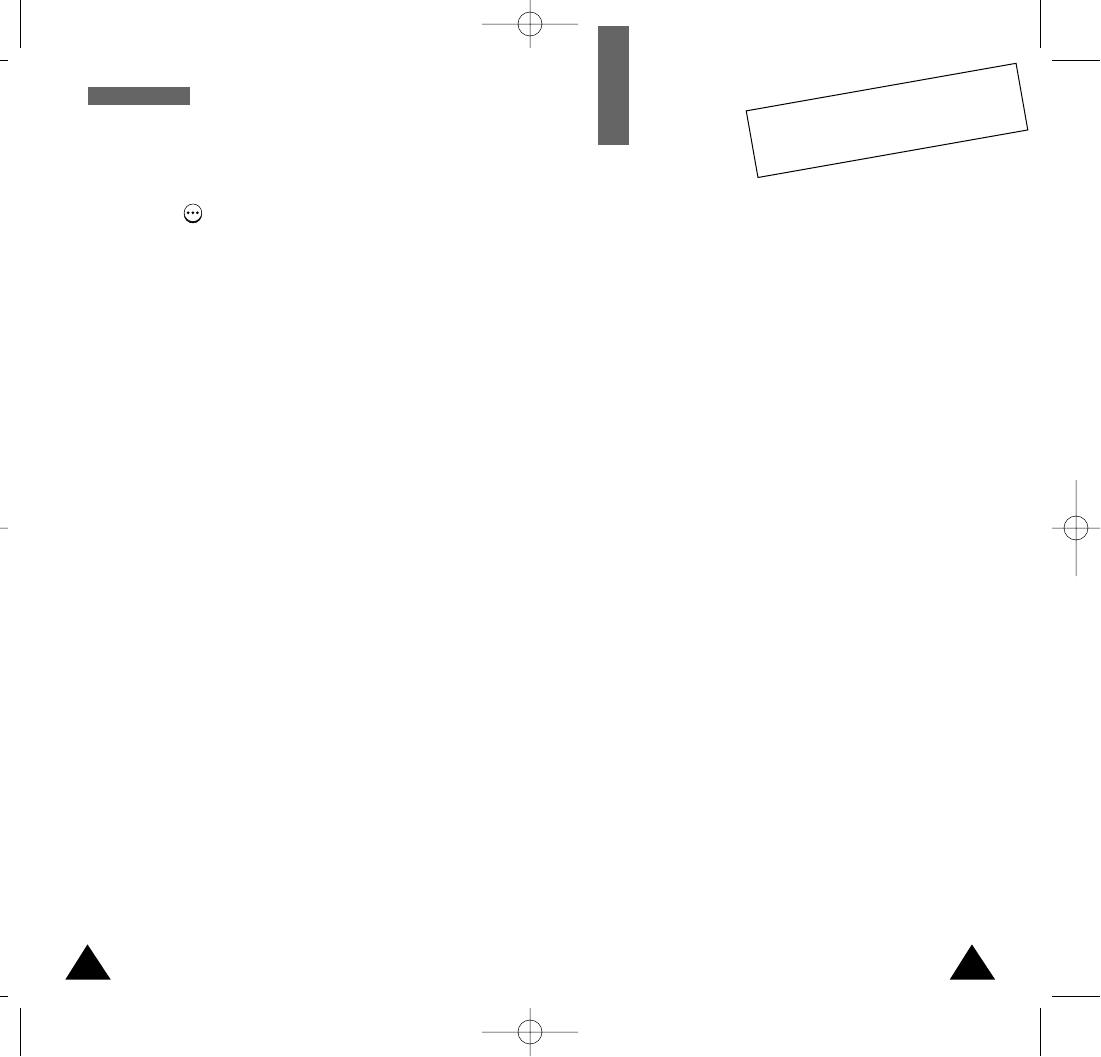
129
A
Accessories • 7
Adjusting volume • 22
Alarm (5.4) • 76
Alert Type (3.3) • 59
Answering
a call • 22
a second call • 42
Answer mode (4.5) • 66
Auto Redial (4.4) • 66
B
Backlight • 13; 64
contrast • 65
Batteries
charging • 16
installing • 14
low battery indicator • 17
precautions • 94
removing • 15
C
Calculator (5.5) • 78
Calendar (5.1) • 70
Caller
group • 36
ID • 23
Calling card(4.9) • 68
Calls
answering • 22
a second call • 42
conference • 43
diverting (7.1) • 81
ending • 21
holding • 39
incoming (1.2) • 51
international • 20
making • 20
missed • 23; 50
outgoing (1.3) • 51
records (1) • 50
redialing automatically • 66
restriction (6.3) • 78
SOS (6.4)• 80
time (1.4) • 51
via the phonebook • 21
waiting (7.3) • 42, 82
Care • 96
Changing
lock code
(6.1)
• 78
security code (6.2) • 78
Characters
entering • 31
Charging batteries • 16
Composer
Melody (3.9) • 61
Conference calls • 43
Connect
to Voice Mail (2.1) • 52
tone (3.8) • 61
Contrast • 65
Correcting numbers • 20
D
Date
format (5.3.4) • 75
setting (5.3.2) • 75
Deleting
memos • 72
missed calls • 25
phonebook numbers • 34
tasks • 74
voice memo • 89
Display • 11
contrast • 69
icons • 12
setting the
language (4.7) • 67
Diverting calls (7.1) • 81
128
Soft Keys
Keys marked on the phone, the purpose of which:
• Varies according to the function that you are
currently using
• Is indicated on the bottom line of the display just
above the corresponding key
TDMA
Time division multiple access (TDMA) is a digital
transmission technology that allows a number of
users to access a single radio-frequency (RF) channel
without interference by allocating unique time slots
to each user within each channel. The TDMA digital
transmission scheme multiplexes three signals over a
single channel. The current TDMA standard for
cellular divides a single channel into six time slots,
with each signal using two slots, providing a 3 to 1
gain in capacity over advanced mobile-phone service
(AMPS). Each caller is assigned a specific time slot
for transmission.
Voice Mail
A computerized answering service that answers a
call, plays a greeting and records a message.
GGlloossssaarryy
The index will be
updated in later version.
Index
07-Glossary 1/25/02 2:04 PM Page 128

131
E
Earphone • 7
Earpiece
adjusting the volume • 20
Editing
memos • 71
messages • 54
missed calls• 24
phonebook numbers • 34
To Do List • 73
Voice memo title • 91
Erasing
memos • 72
missed calls • 25
phonebook numbers • 34
tasks • 74
voice memo • 89
Error Tone (3.6) • 60
F
Functions
selecting • 26
G
Games (8) • 85
Greeting Message (4.1) • 64
Groups
caller • 36
H
Holding calls • 39
I
Icons
description • 12
ID, caller • 23
Identifying a caller • 23
Incoming Calls (1.2) • 50
K
Key tones
adjusting the volume • 22
muting • 41
selecting • 59
sending • 41
Keys
description • 9
location • 8
navigation • 27
L
Language (4.7) • 67
Last number redialing • 21
Length of calls • 51
Letters
entering • 31
Light
backlight • 13; 64
service • 13; 65
Lock code • 78
Locking phone • 19
Low battery indicator • 17
M
Maintenance • 98
Melody Composer (3.9) • 61
Memory status • 38
Memos
editing • 71
erasing • 72
writing • 71
Menus
by scrolling • 44
by shortcut • 45
list • 46
using • 44
Message Tone (3.5) • 60
Messages
greeting (4.1) • 64
preset (2.4) • 56
reading (2.2) • 53
setup (2.5) • 56
voice mail (2.1) • 52
writing (2.3) • 55
130
M
(continued)
Microphone mute • 40
Minute Minder (3.7) • 61
Missed calls (1.1) • 50
deleting • 25
editing the number • 24
viewing • 23; 50
Mute
key tones • 41
microphone • 40
N
NAM, selecting (7.5) • 84
Names
entering • 31
options • 36
searching/dialing • 35
storing in the
phonebook • 30
Network Selection (7.3) • 82
Network Services (7) • 81
Number
correcting • 20
editing
missed call • 24; 50
phonebook • 34
erasing phonebook • 34
moving phonebook • 35
own • 38
redialing • 21
automatically • 66
searching/dialing •
35
storing in the
phonebook • 30
O
Options
selecting • 26
Organizer (5) • 70
Outgoing Calls (1.3) • 51
Own Number • 38
P
Phone
locking • 19
Settings (4) • 64
switching on/off • 18
Phonebook • 30
dialing • 35
editing numbers • 34
erasing numbers • 34
making calls • 20
moving numbers • 34
options • 33
searching • 35; 41
storing numbers/names
• 30
Playing, voice memo • 89
Preset Message List (2.4) •
56
Problem solving • 92
R
Read Messages (2.2) • 52
Recording,
voice memo • 88
Redialing
automatically • 66
last number • 21
Replaying,
voice memo • 89
Reset Settings (4.8) • 67
Restriction, call • 79
Ring
Tone (3.2) • 58
type • 59
Volume (3.1) • 58
Roaming • 82
IInnddeexxIInnddeexx
07-Glossary 1/25/02 2:04 PM Page 130